↠ Sponsored post ↞
Dark clouds hung over us as we set off from my hometown of Hov, to one of my favourite islands in the world. I was on my way to Tunø with my friend Amanda, on a mission to explore the island in depth.
Tunø is a rather unique island. It’s one of a few car-free islands in Denmark, and with a one-hour journey from the mainland and no connection to the neighbouring island of Samsø, it’s rather isolated from the rest of the country. Life on the island is slow and serene and the atmosphere is quite special. It’s an island I’ve always recommended to travellers who want to experience the best of Denmark in a small package – from lush forests, sandy beaches and high coastal cliffs to a cozy village, rural farms and a church tower that also functions as a lighthouse. Tunø has something to offer for everyone.
Over the sea to Tunø
Tunø’s lifeline to the mainland is M/F Tunøfærgen, which sails between the island and Hov 2-3 times per day. The ferry can fit around 200 passengers and four cars although the crossing is usually car-free. Amanda and I caught the morning ferry and spent the next hour staring out at the Kattegat Sea and the hilly island as we approached it.
But our distant stares into the horizon were soon broken up by an invitation to see the control room and meet the captain for a little chat about the ferry.
M/F Tunøfærgen has only been sailing the route since 1993. In the past, Tunø was much better connected to the rest of Denmark, in fact, it was once connected to Zealand as well as Jutland by the tiny cutter M/S Tunø that transported passengers from the island to Kalundborgfærgen, which sailed between Aarhus in Jutland, the island of Samsø and Kalundborg on Zealand. Although M/S Tunø no longer serves as a connection to the mainland, the wooden veteran ship is still used during the summer for trips between Tunø and Samsø. Now that is an experience I must have someday!
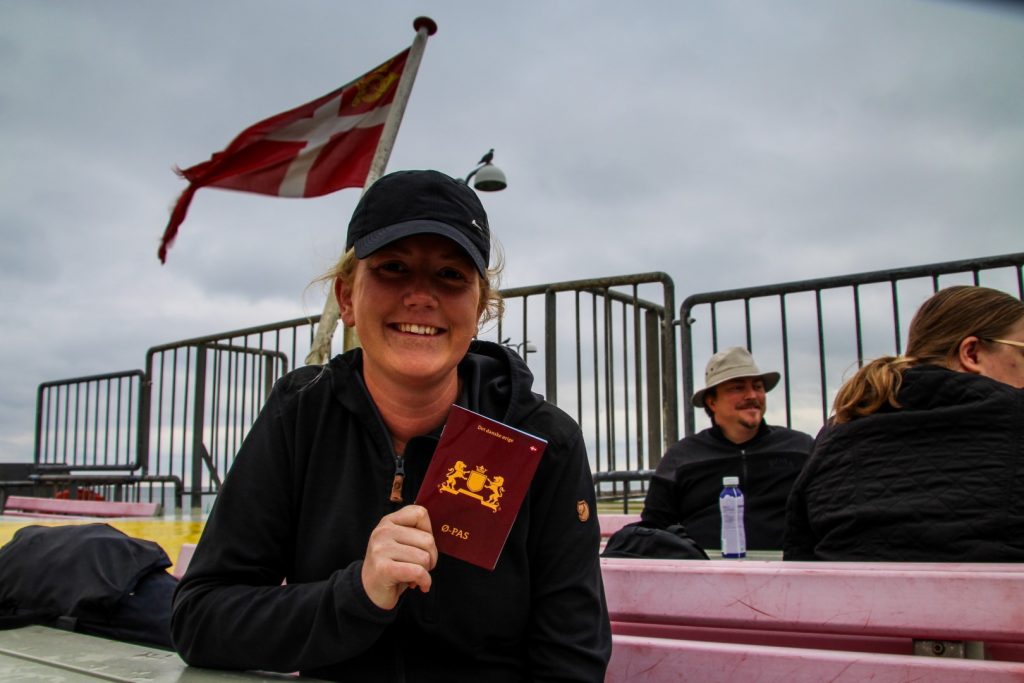
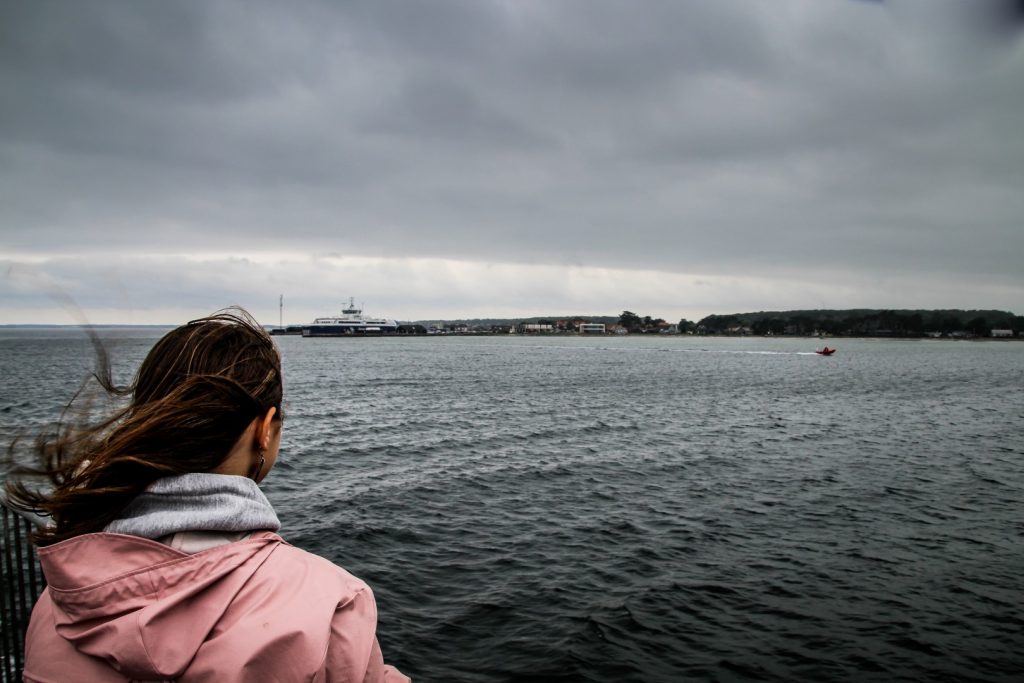
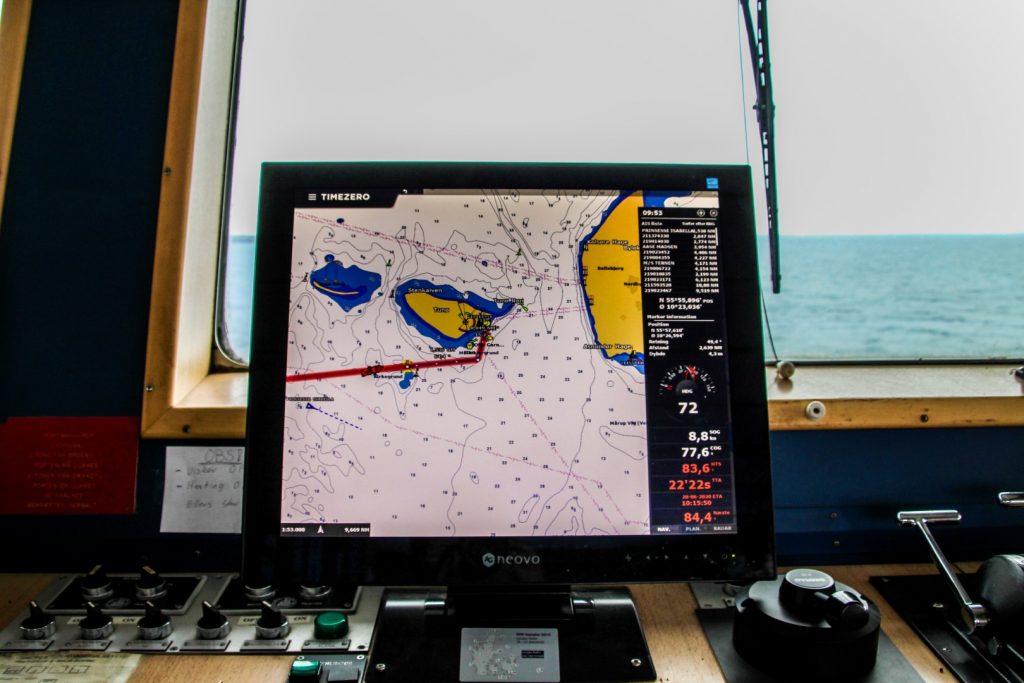
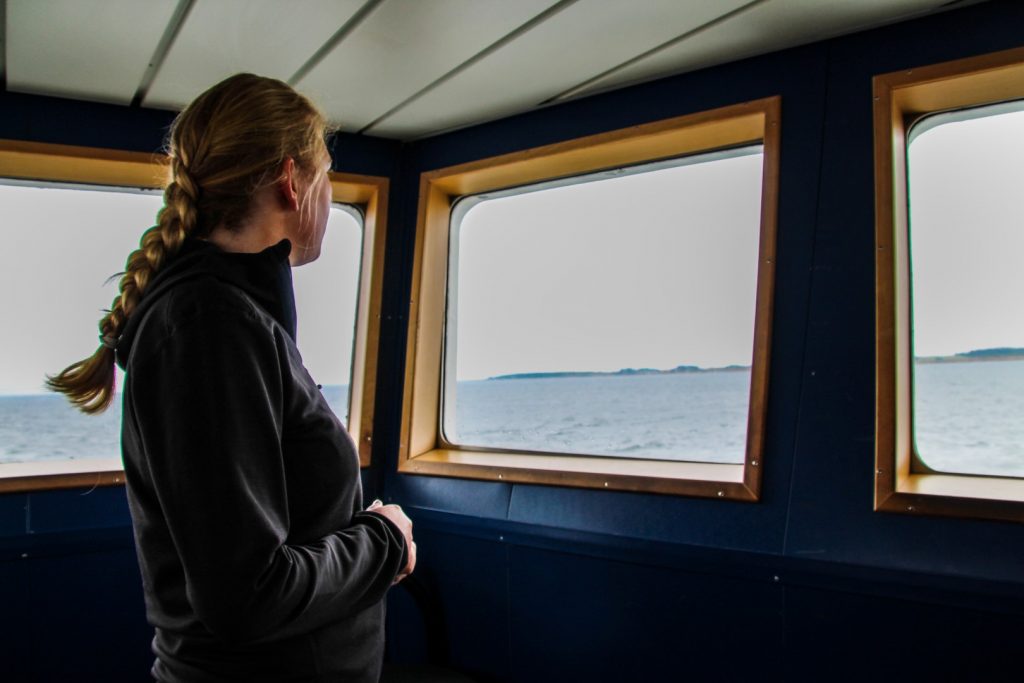
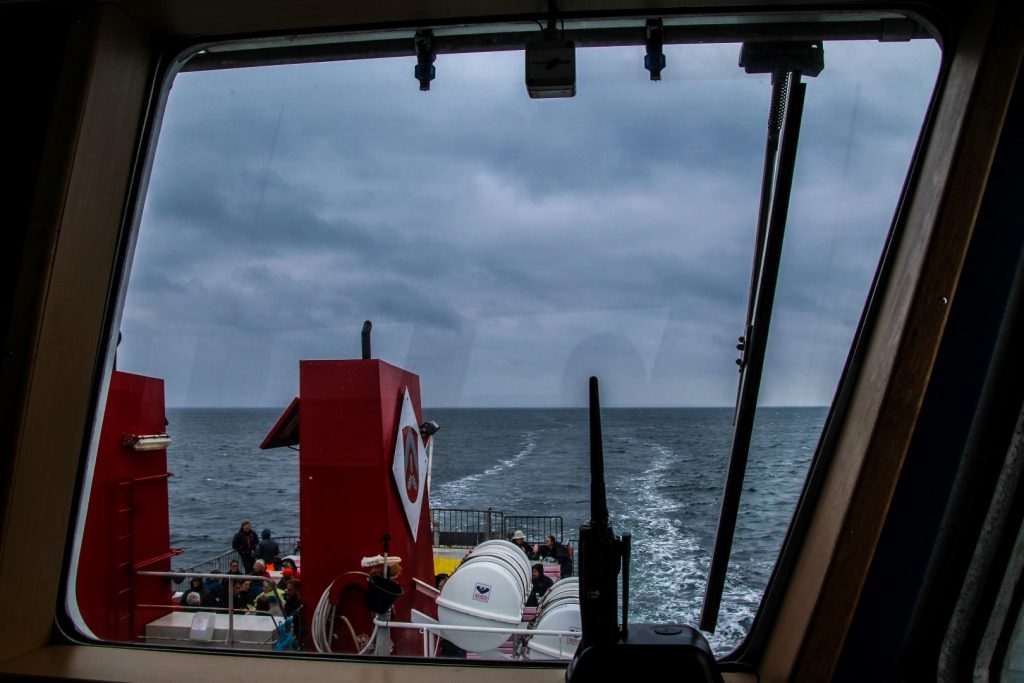
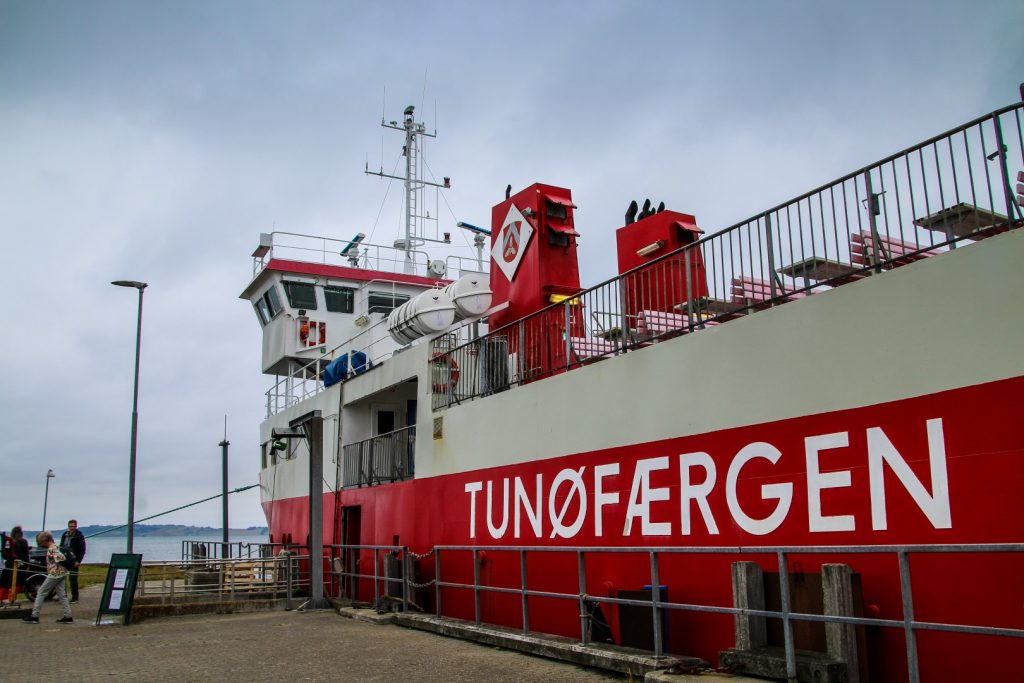
Cabin life on the island
An hour soon went and we arrived at the tiny harbour, which was full of private boats. Tunø is a popular place to visit during the summer, even on a cloudy day. The dark clouds had kept dry during the entire journey, but decided to spit on us when we arrived. Thankfully, the little shower didn’t last long and it stayed dry for the rest of the day (much to our pleasant surprise considering how bad the weather report had been!).
As soon as our feet touched land, we headed to the island’s campsite where a cozy wooden cabin awaited us. The cabin sleeps four people, so we had plenty of space since we were only the two of us! As soon as we’d settled in, we headed out to see a bit of Tunø.
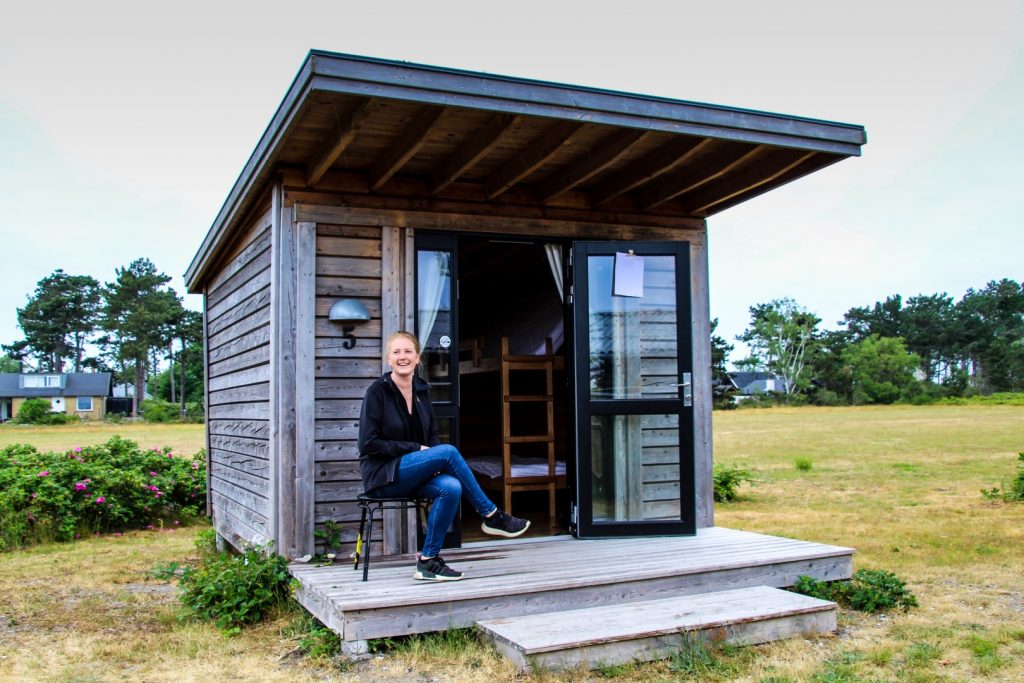
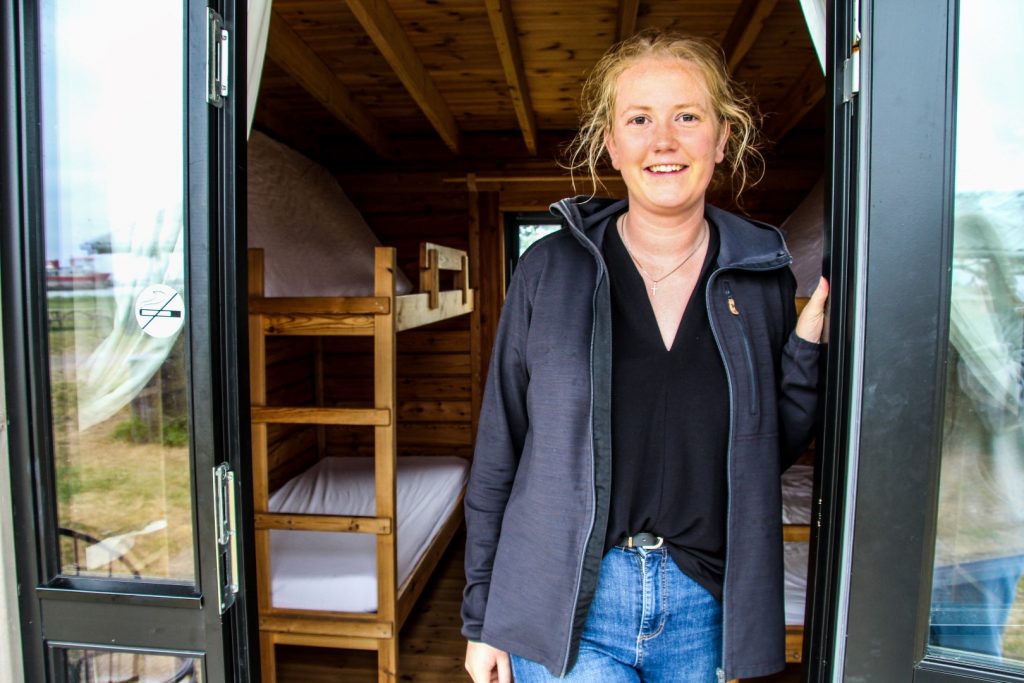
A walk to Revet, the home of the cormorants
From the ferry, we’d spotted a tiny piece of land protruding into the ocean, an area known as Revet. The small protrusion offers two exciting sights; a flock of cormorants that seem to enjoy hanging out at the very edge of it, and a phenomenon similar to that of the famous Grenen in Skagen and the lesser known Øverste Ende on Endelave, where crashing waves from the wind side meet the calm water on the sheltered side.
The wind was strong at Revet, but we braved it out to the very edge after watching the cormorants fly away. But just as I was capturing the moment on video, a huge wave came crashing in and we had to run to save our shoes from being drenched… We weren’t successful.
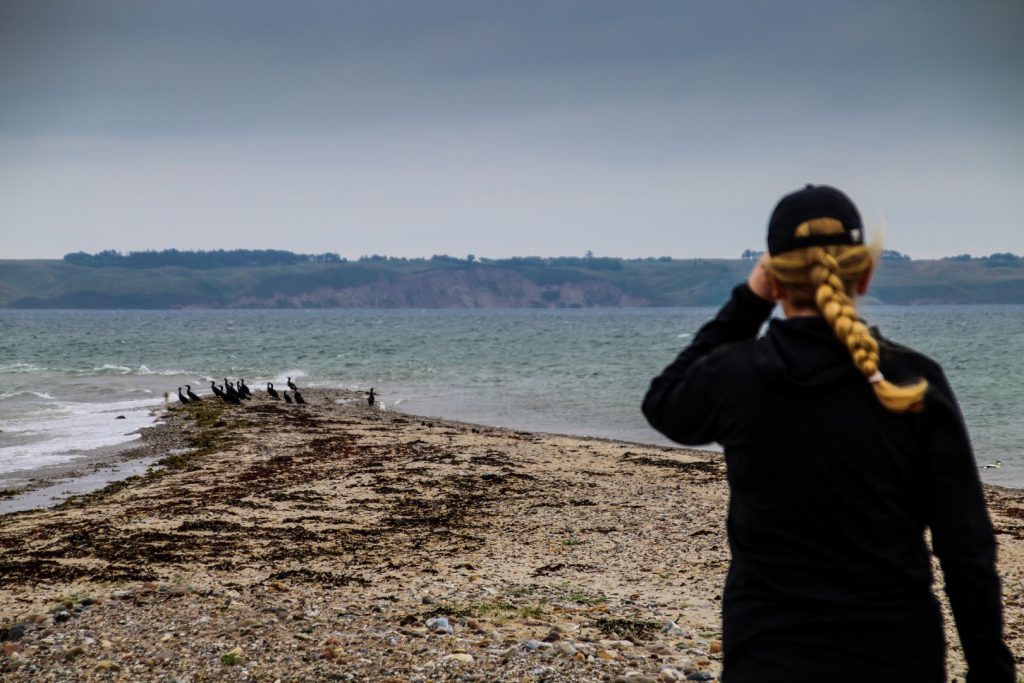
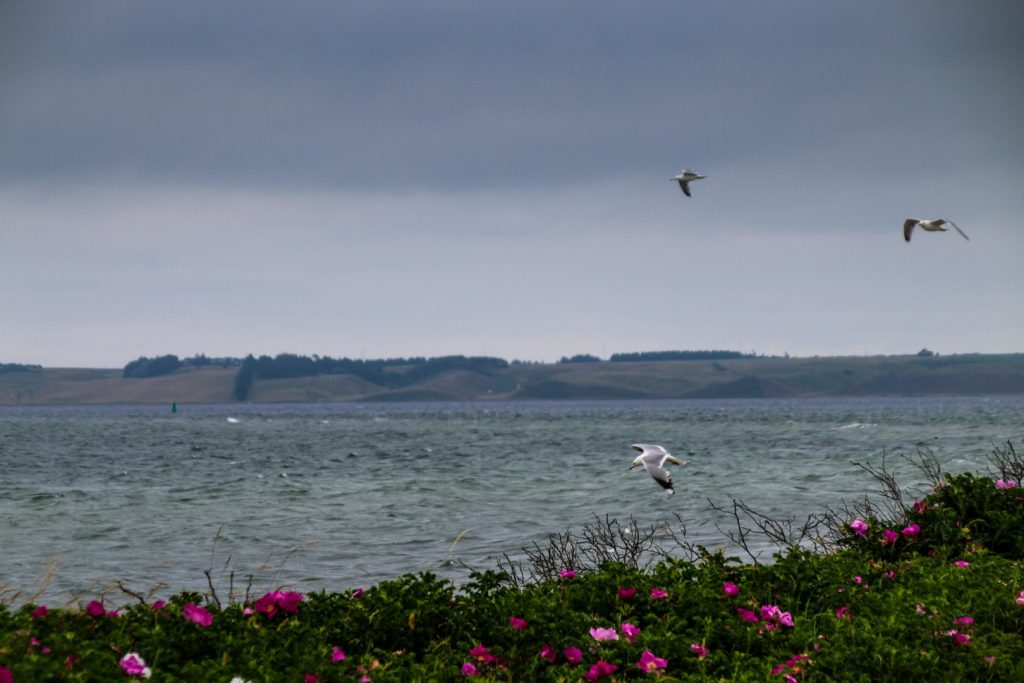


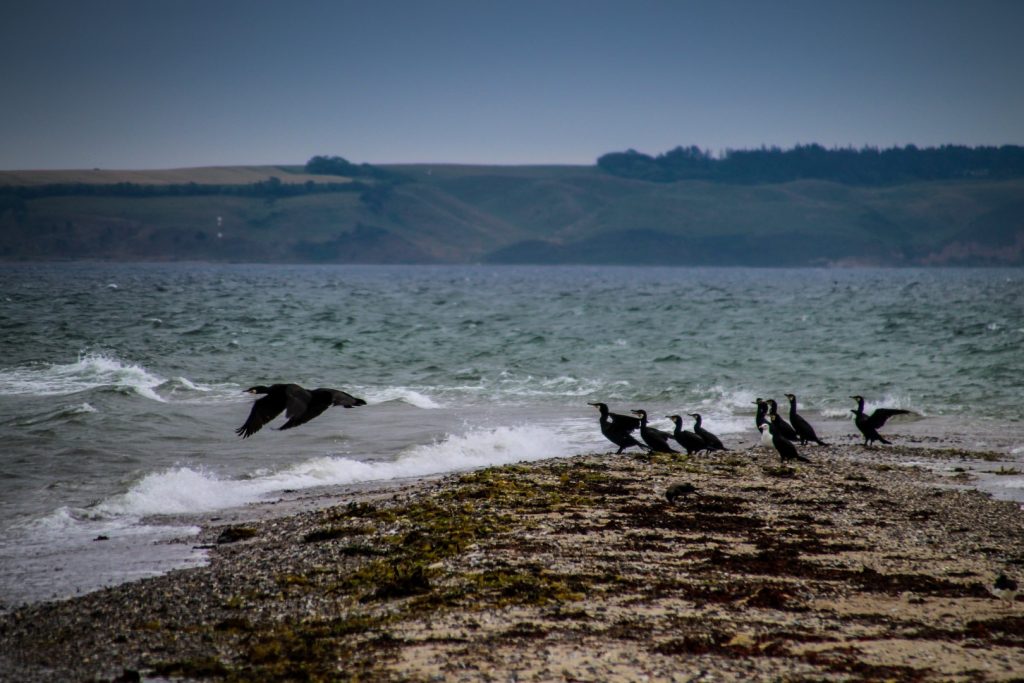
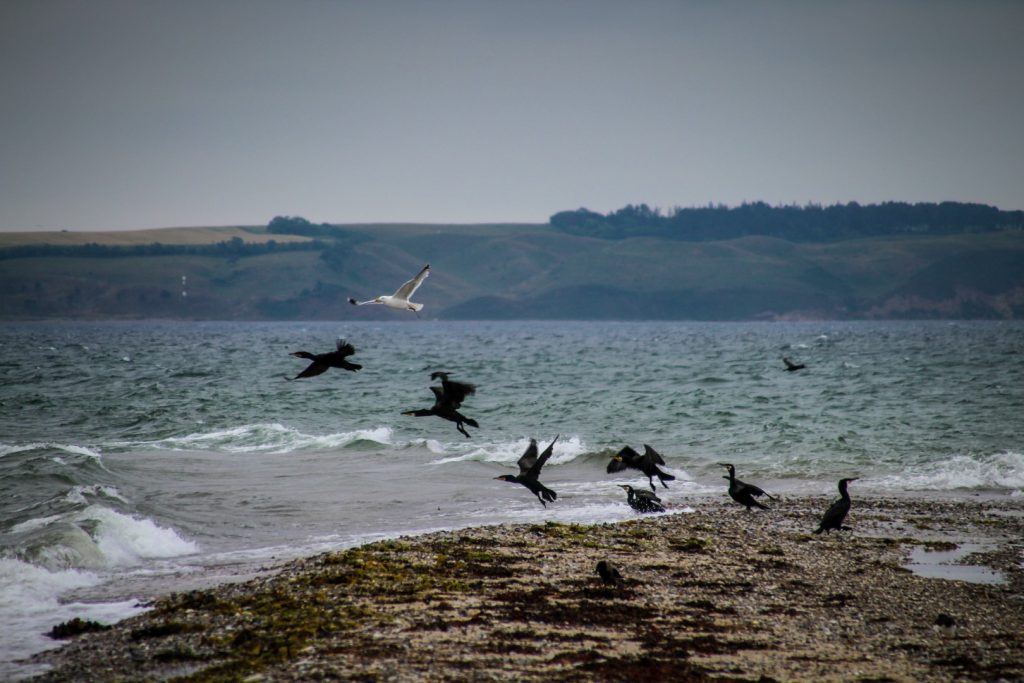
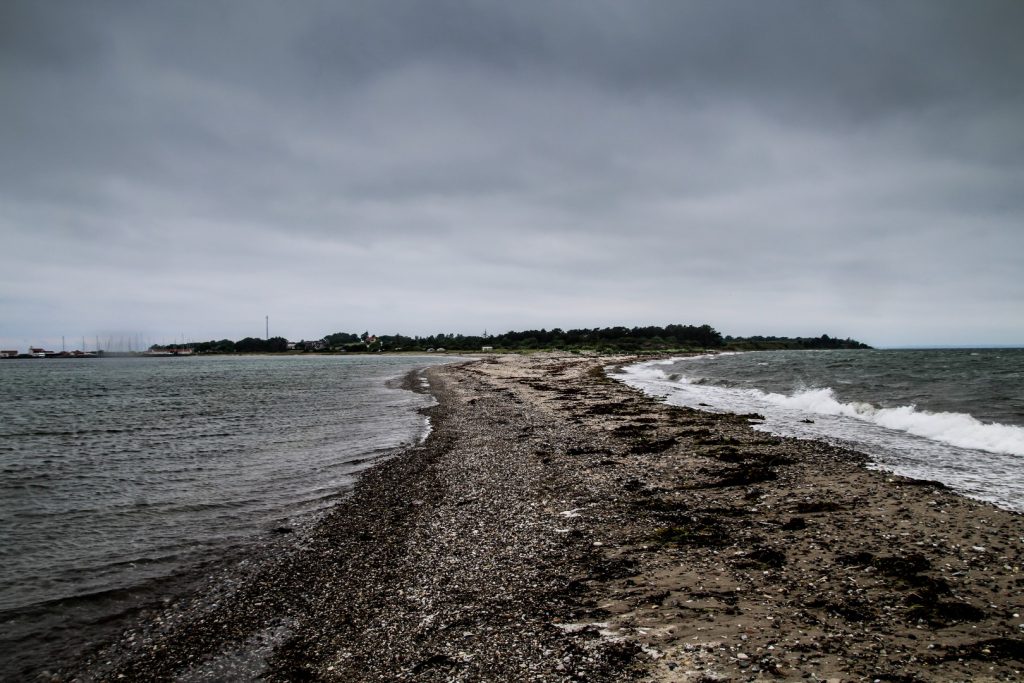
The quaint village of Tunø
So with wet feet, we continued our explorations of the island and headed into its only village.
Tunø is tiny, in fact it’s only 3,52 km² and is home to just 105 islanders, most of whom live in the village. Unlike most other Danish islands, the houses on Tunø don’t date back very far due to a huge fire in 1852 that destroyed 16 farms and 15 houses in the village. This fire also resulted in a relocation of most of the farms which were rebuilt in more rural settings.
But the fact that the oldest houses are less than 200 years old does not make the village less charming. In fact, it’s one of the most idyllic and picturesque villages I know of, and despite the low number of inhabitants, the village has a lot to offer. It’s home to cafés and restaurants, a grocery store with an adjacent café, a school, a museum and archive, local craft shops, a beautiful gallery and small roadside stalls where local seasonal vegetables can be purchased.


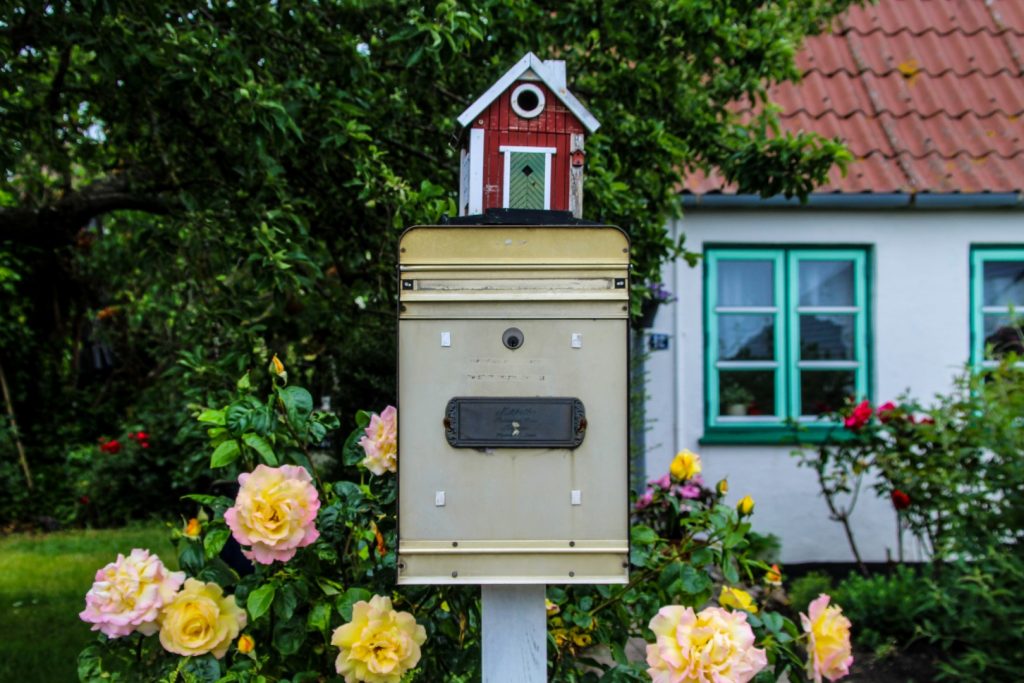

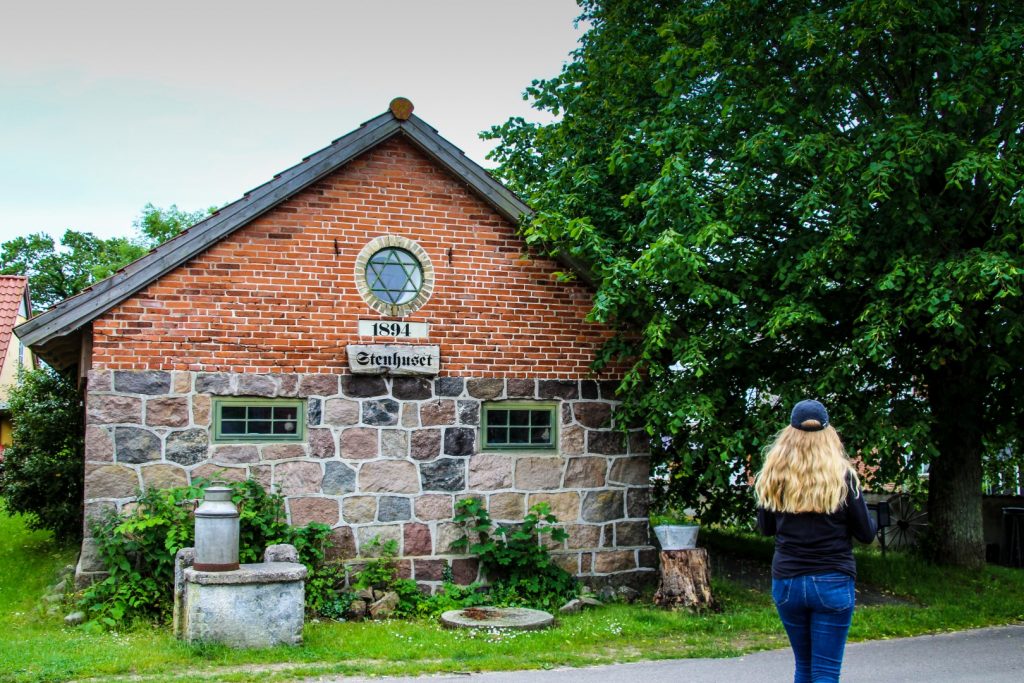
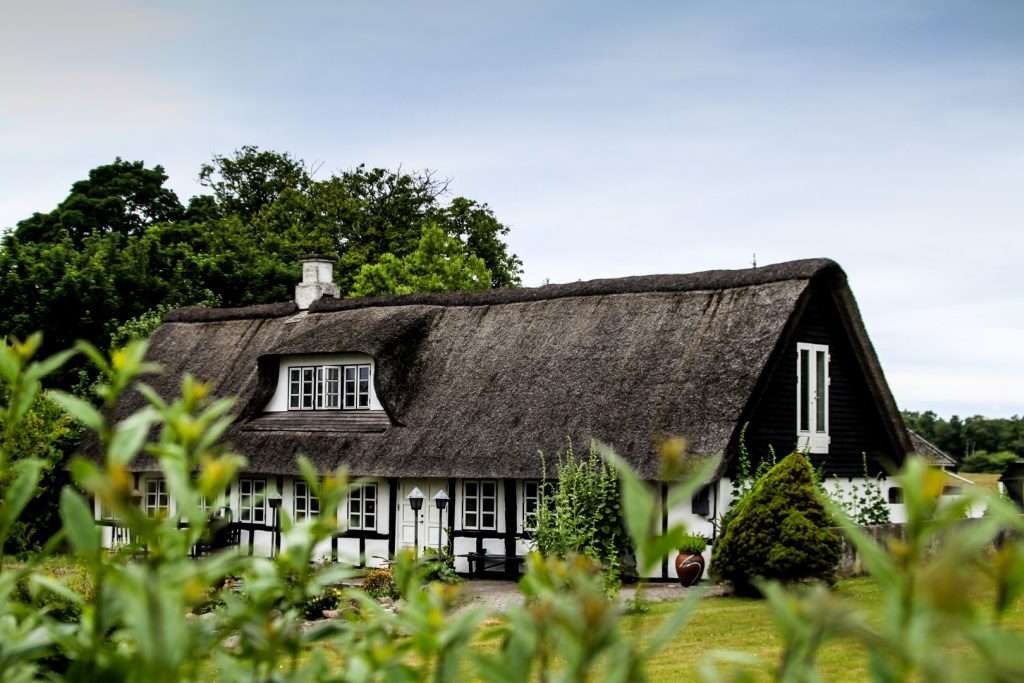
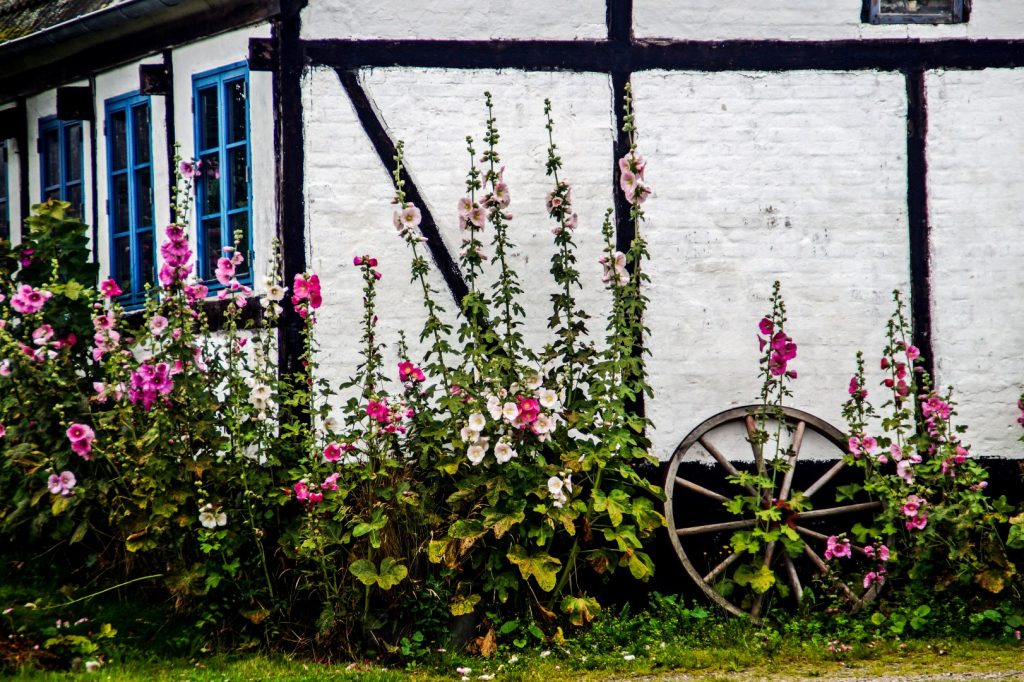
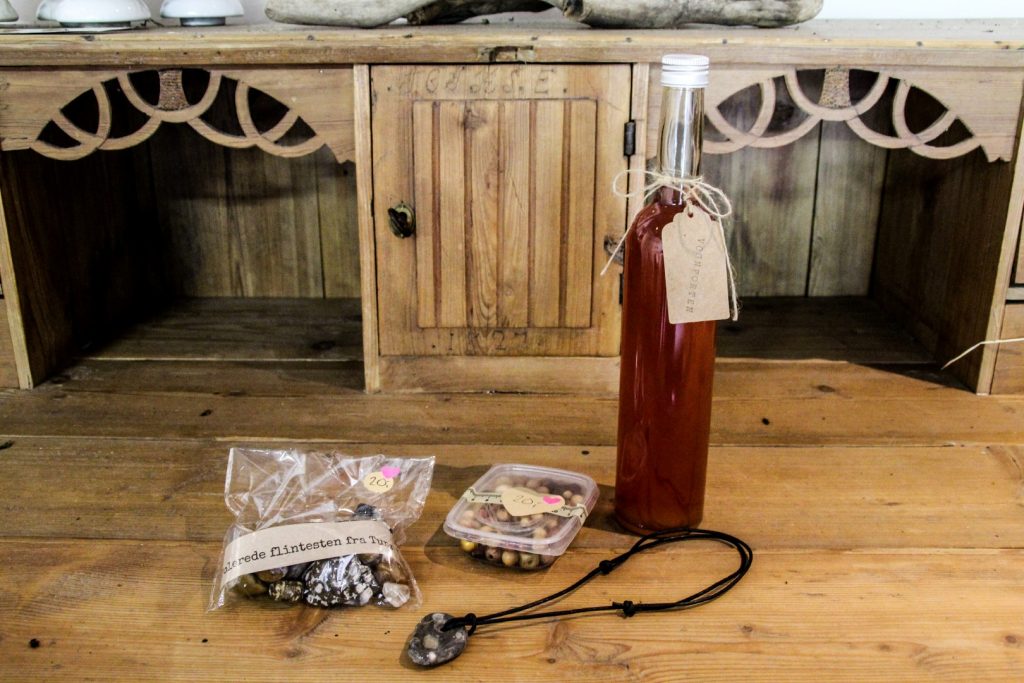
By the overgrown pond is one of the more unique buildings in town; the old smithy, a small low-ceilinged house from around 1800 which stands untouched since the last blacksmith left sometime in the 1960s. For as long as I can remember, the doors of the smithy have been unlocked so anyone could enter and feel the breath of history.
After we’d taken a little stroll through the village, we settled down at one of the island’s restaurants, Mejeriet Tunø, for a coveted lunch. Amanda enjoyed a delicious burger, while I had a plate of fries which I’d craved the entire day.
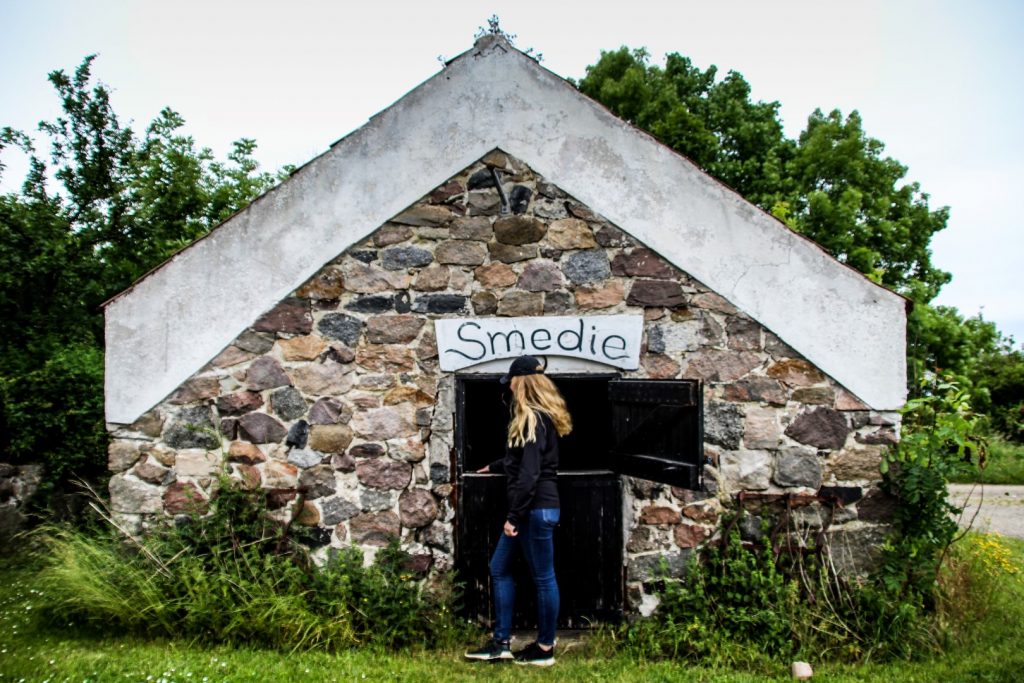

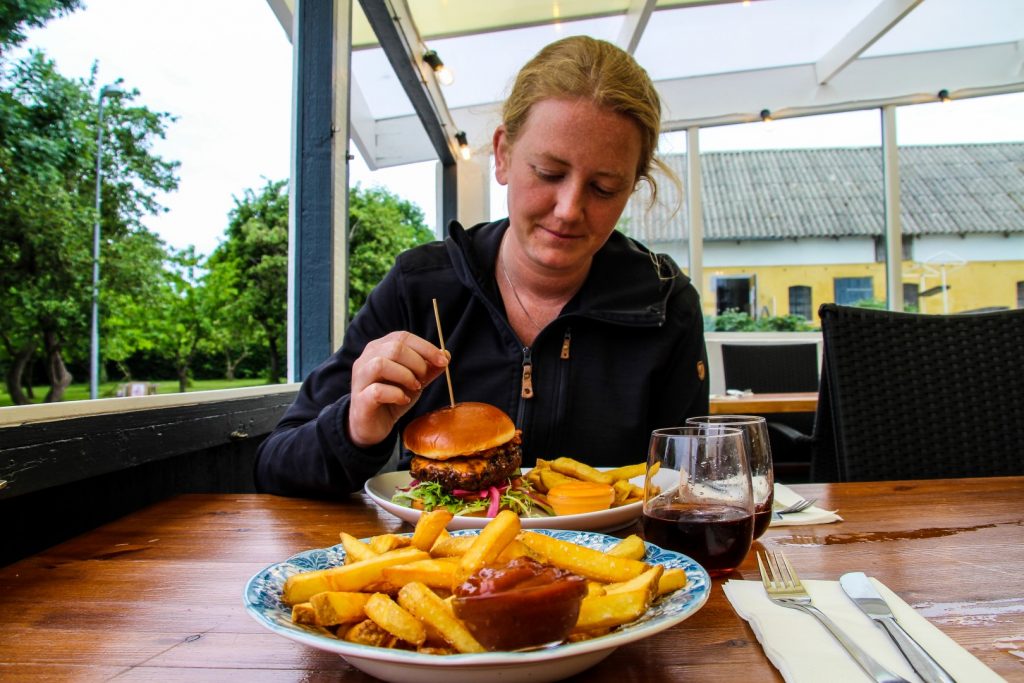
Tunø from above – a visit to the church tower/lighthouse
Tunø’s superstar is located in the center of the village – it’s the 14th century church, or rather, it’s tower. Because the tower is not simply a church tower, it also quite uniquely houses a lighthouse. The church tower was chosen as the location for the lighthouse in 1801. It was later heightened with seven meters to eighteen meters, creating not only a better lighthouse but also the perfect lookout tower.
Despite the fact that the lighthouse is still in use today, the tower is frequently visited by those who want to enjoy a panoramic view of Tunø, but due to Covid-19 it was closed while we were there. Luckily, we’d been given the number of Michala, the island’s gravedigger, who took us on a private tour up the many narrow steps to the top of the tower.
The view up there is incredible. We could see the entire island, from Revet in the east to Stenkalven in the west, as well as a first-class view of the village with a backdrop of the neighbouring island of Samsø.

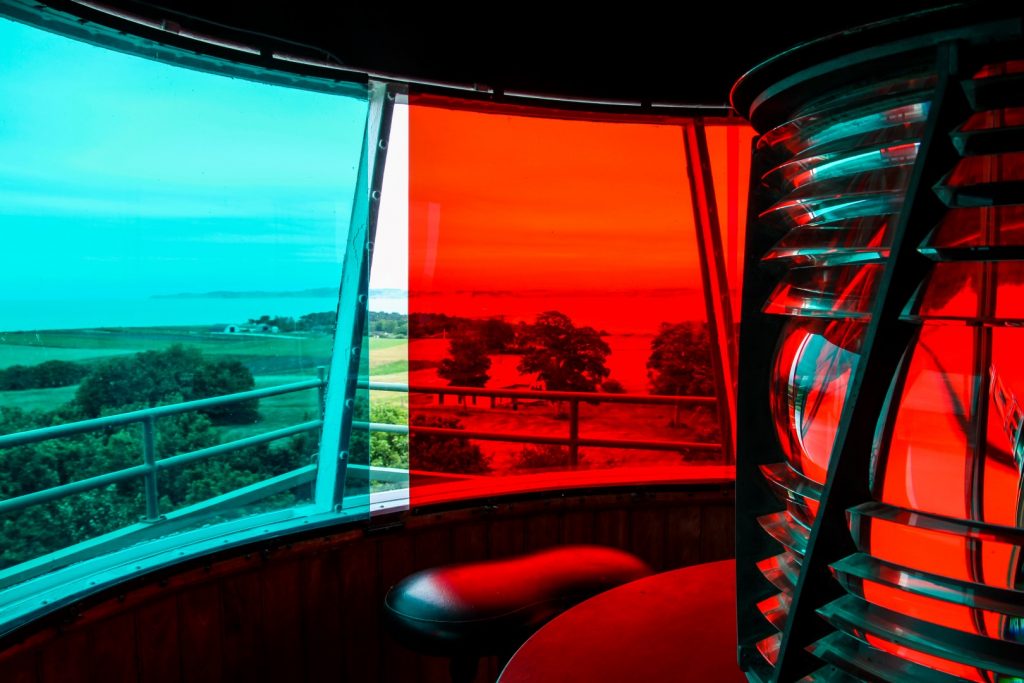
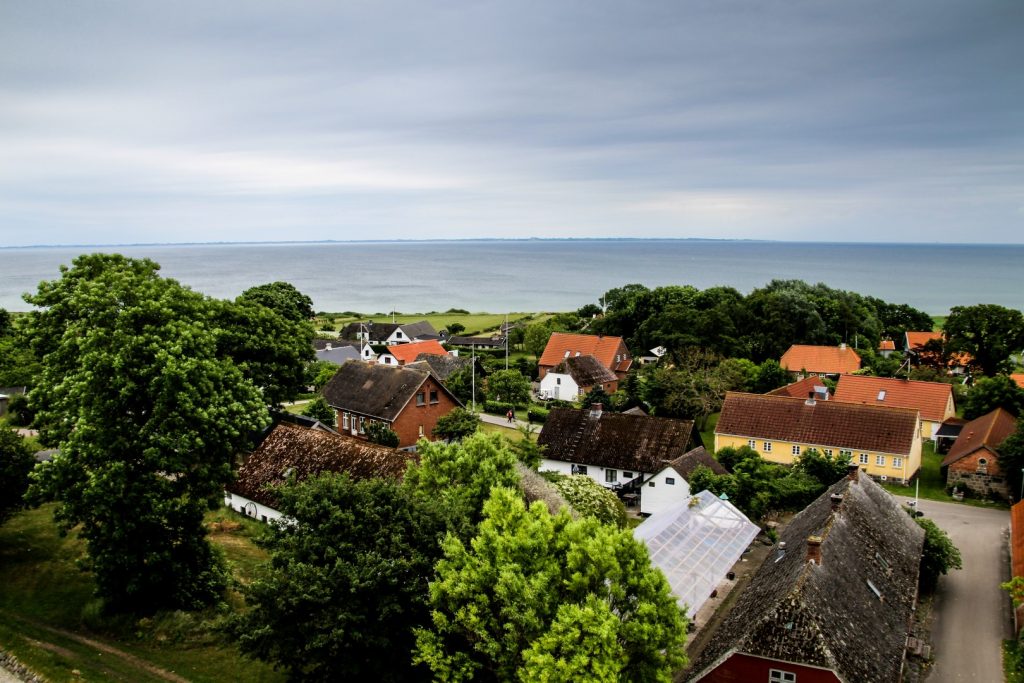
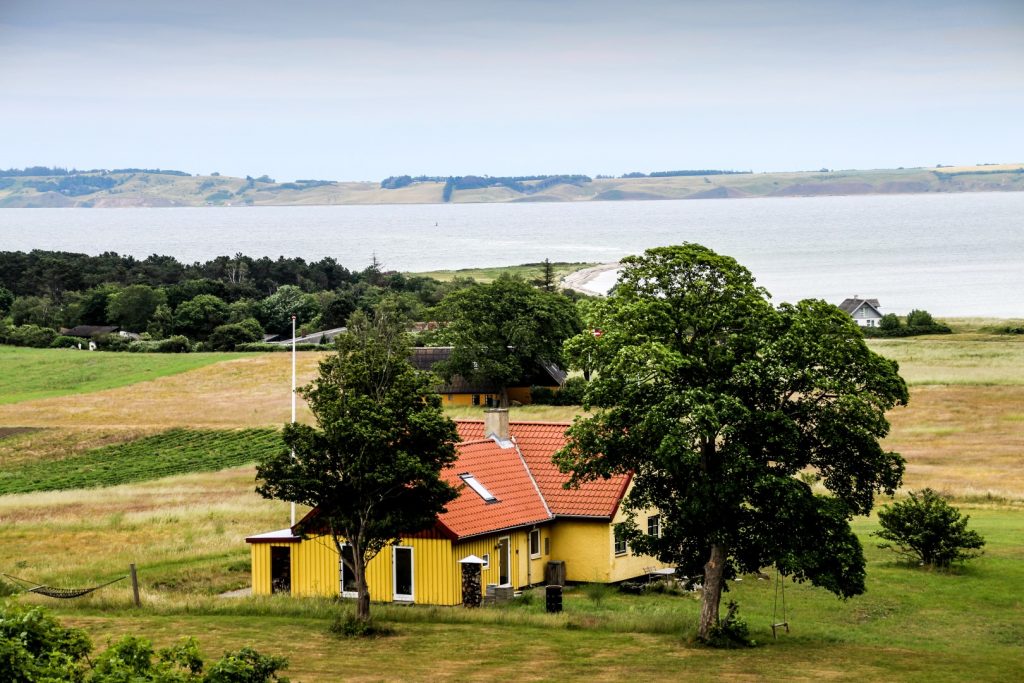
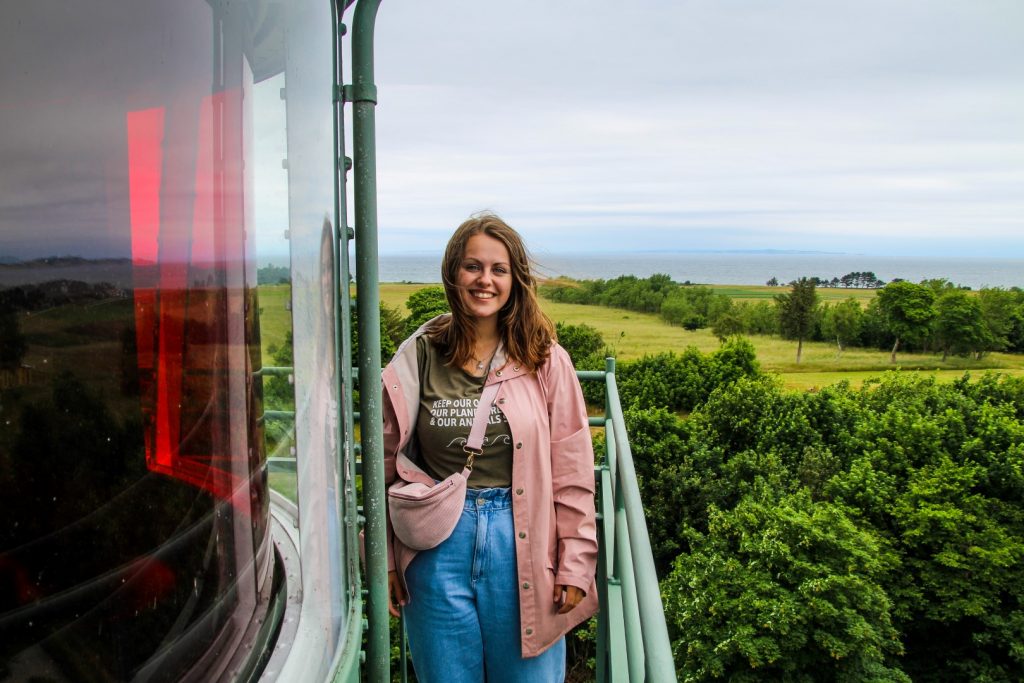
The secret cup mark stones
Before we parted ways with Michala, I asked her whether or not Tunø has any archaeological sights worth seeing since I couldn’t remember any despite finds revealing that the island has been inhabited since 2,500 BC. She told us about 3-4 cup mark stones from the Neolithic or Bronze Age, which are all taken out of their original contexts and placed in the village.
She pointed two of them out for us, and once I saw them, my eyes nearly popped out of my head! They are FULL of cup marks, one of them in particular which is large in size but unfortunately incorporated into a wall so only one side is visible. But WOW, I couldn’t believe I hadn’t spotted them before! In all of my years of visiting Tunø, even as an archaeologist, I never heard about or noticed these cup mark stones. Michala opened my eyes to the archaeological importance of Tunø!
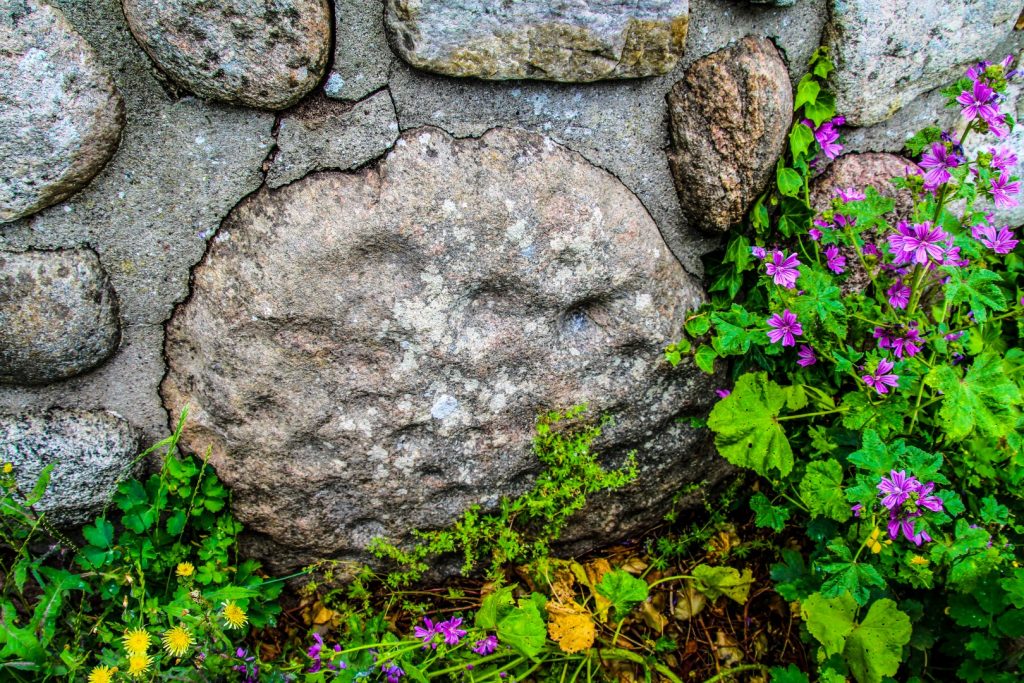
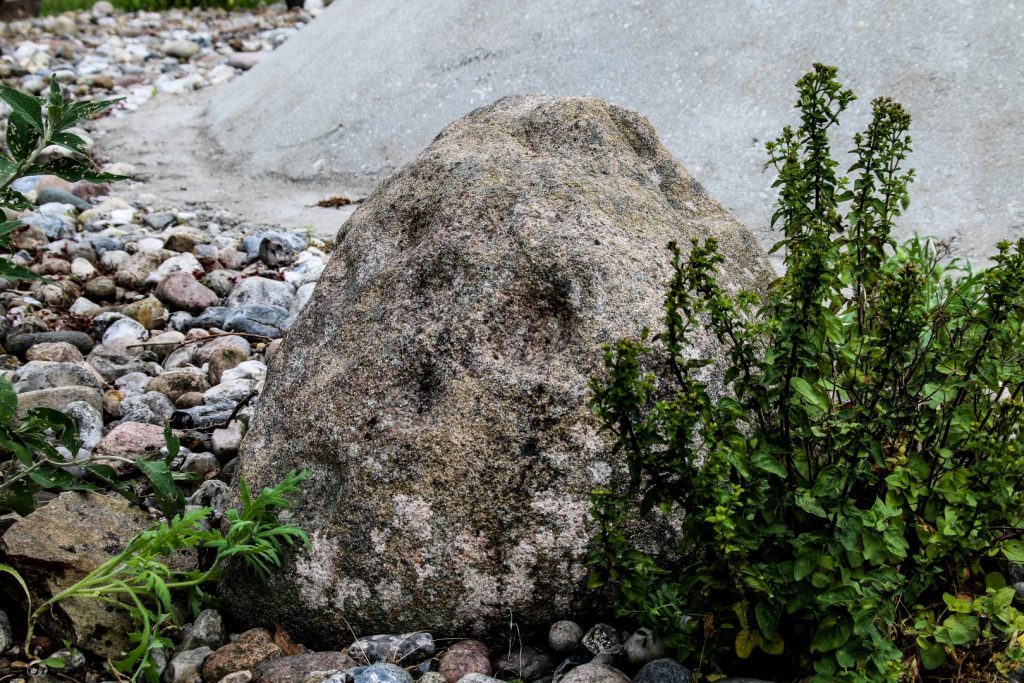
A competitive game of minigolf
After our visit to the church tower/lighthouse, we decided to pay a visit to the minigolf course for a competitive game. The course is set in beautiful surroundings by a yellow farm just outside of the village. Both Amanda and I are sore losers and awful winners, so it was a fun game with lots of tension – but we both agreed that our attitudes would end after the game.
I ended up with a victory and tried my hardest to control myself. Thankfully, Amanda is still my friend today. Haha!

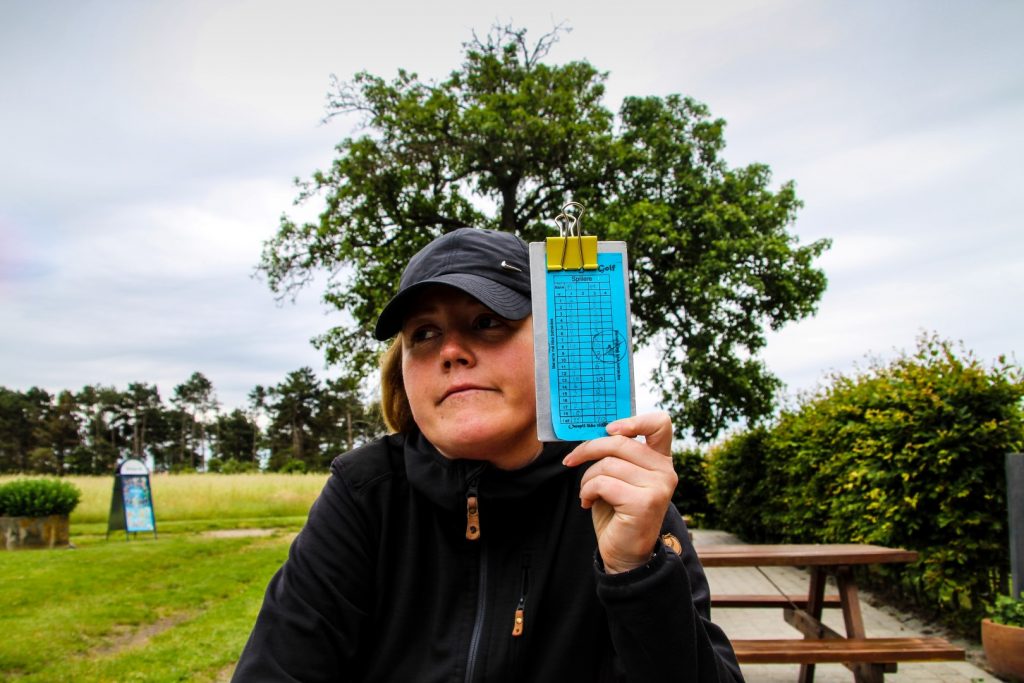
A well-tasting evening at Mejeriet Tunø
After yet another walk through the quaint village, we returned to Mejeriet Tunø for an evening of exquisite taste experiences and cozy atmosphere. We were served a three-course vegan dinner that consisted entirely of local produce and wild herbs from the island.
The food we enjoyed that evening was much fancier than the vegan food I’m used to, in fact I think it’s the fanciest food I’ve ever tried. My taste buds were constantly challenged in the most satisfying way. Tasting Tunø was the perfect way to end a wonderful day.
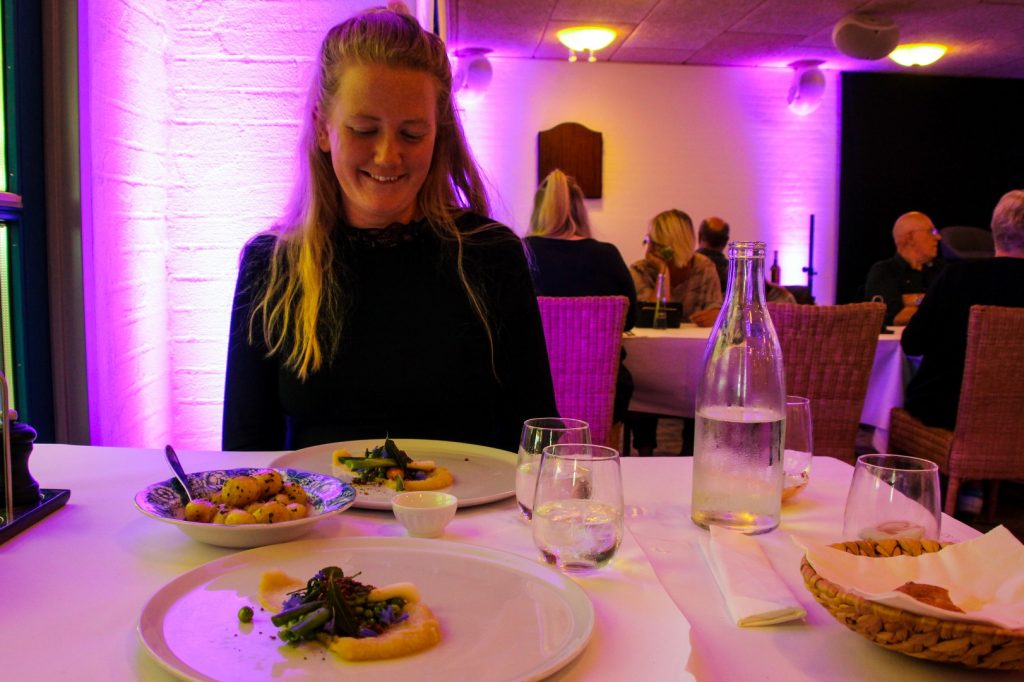

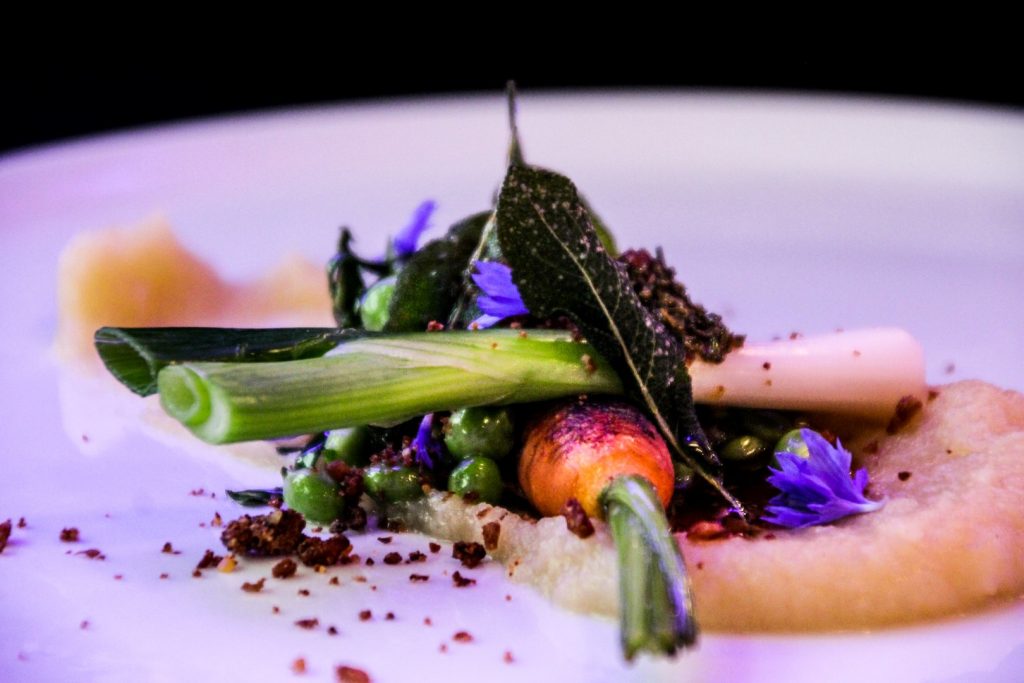
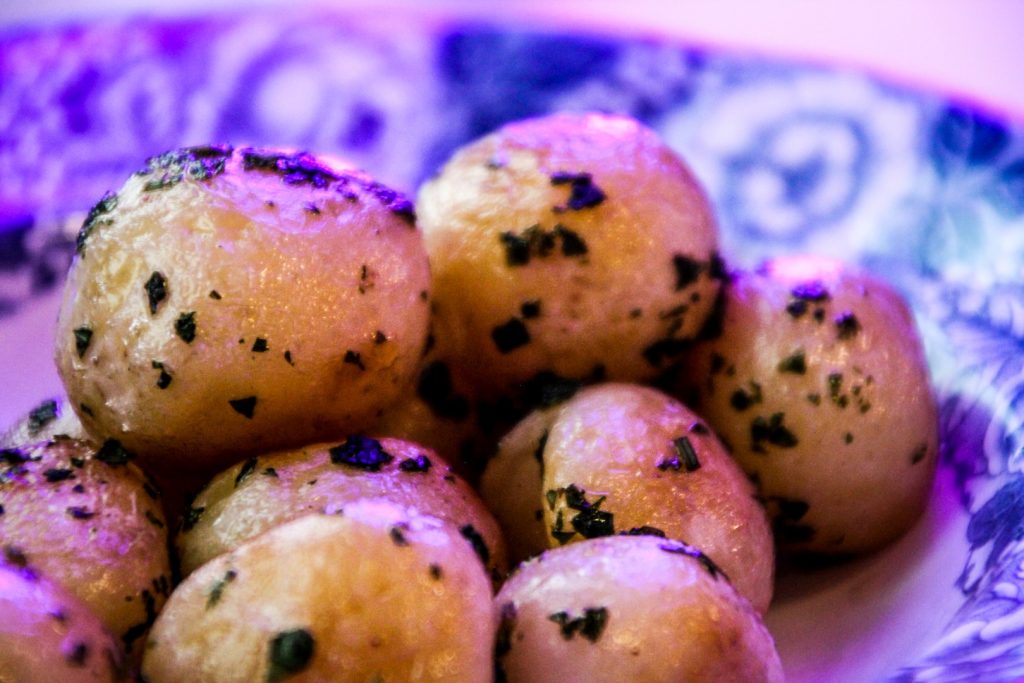
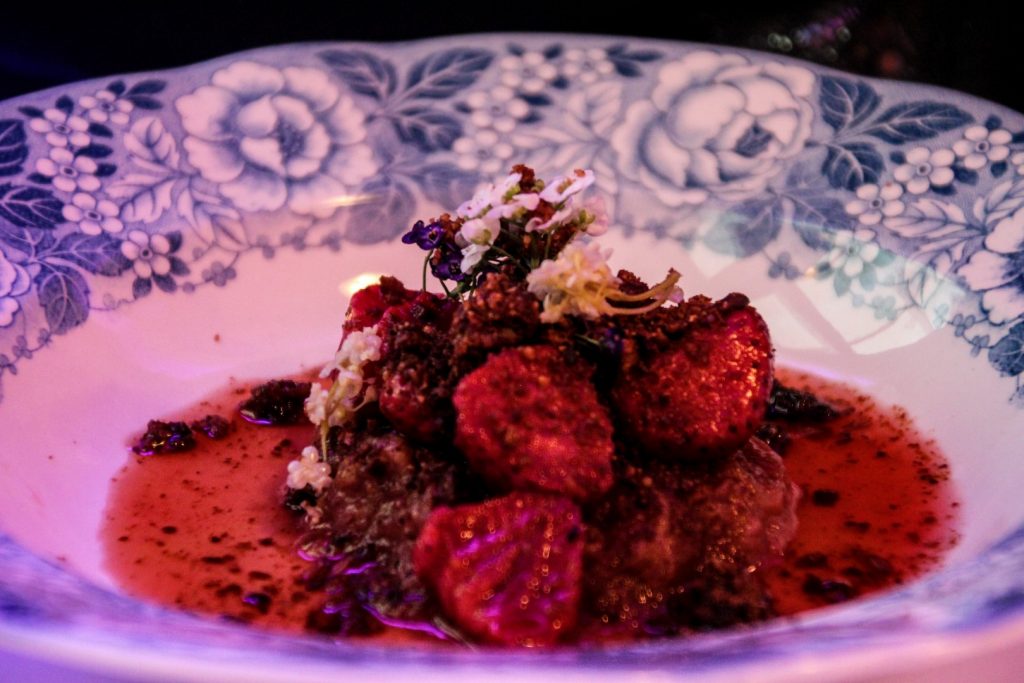
A sunset to brighten the sky
As we walked out of Mejeriet Tunø, we noticed that the grey clouds had given way to a blue sky that was turning orange. Sunset was underway and we didn’t want to miss it.
We hurried down to the harbour where we found the perfect view over a vast field. It gave us a clear view of the beautiful setting sun that disappeared below the horizon with a promise of a sunny tomorrow.
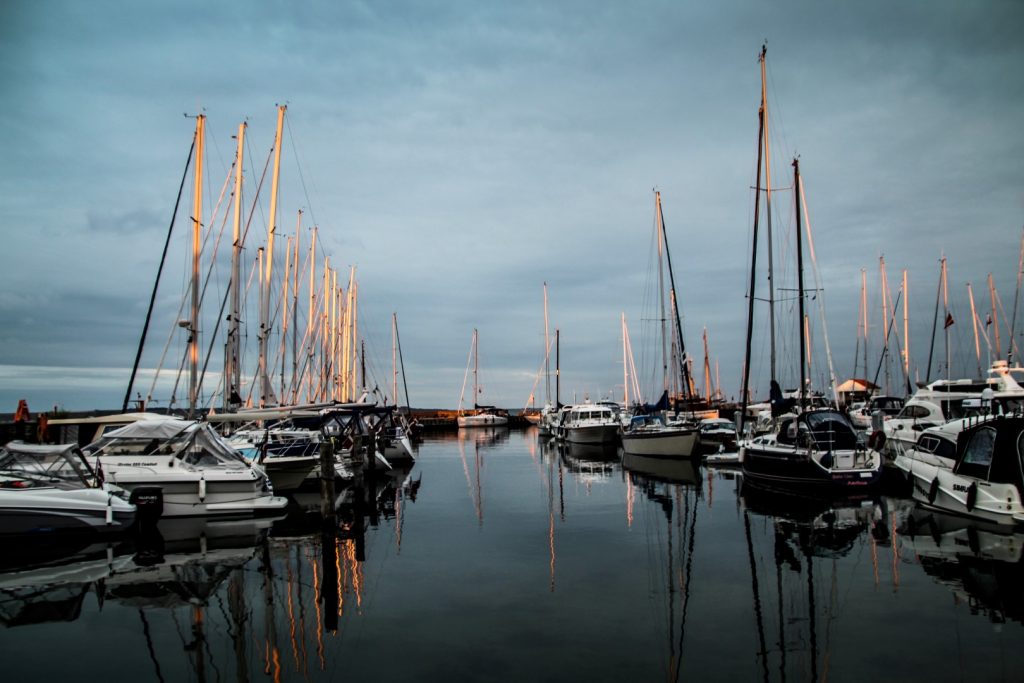
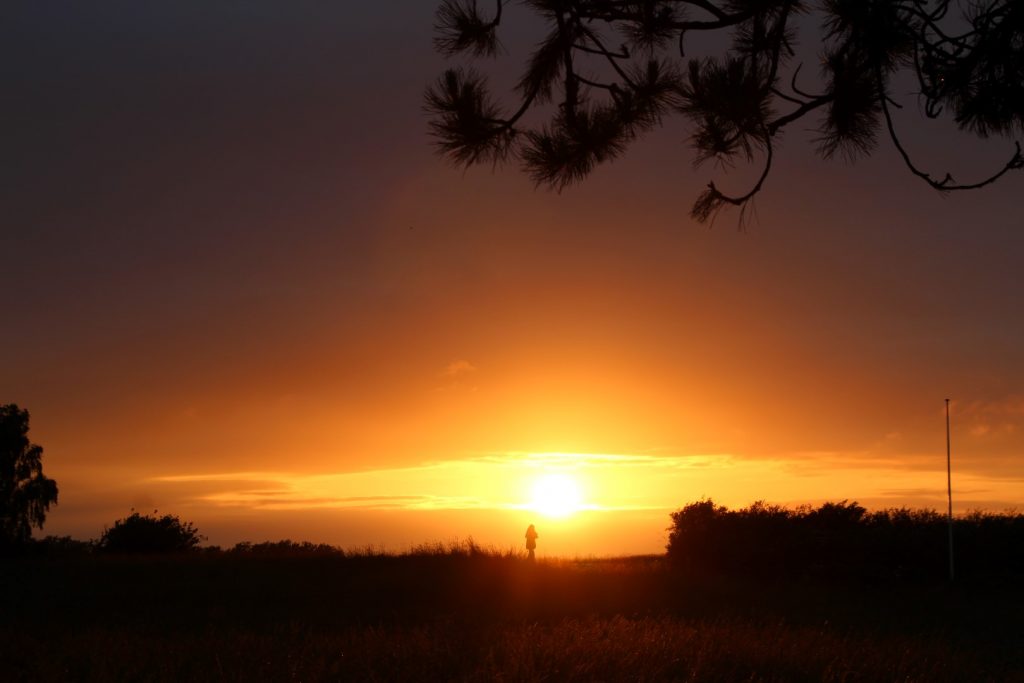
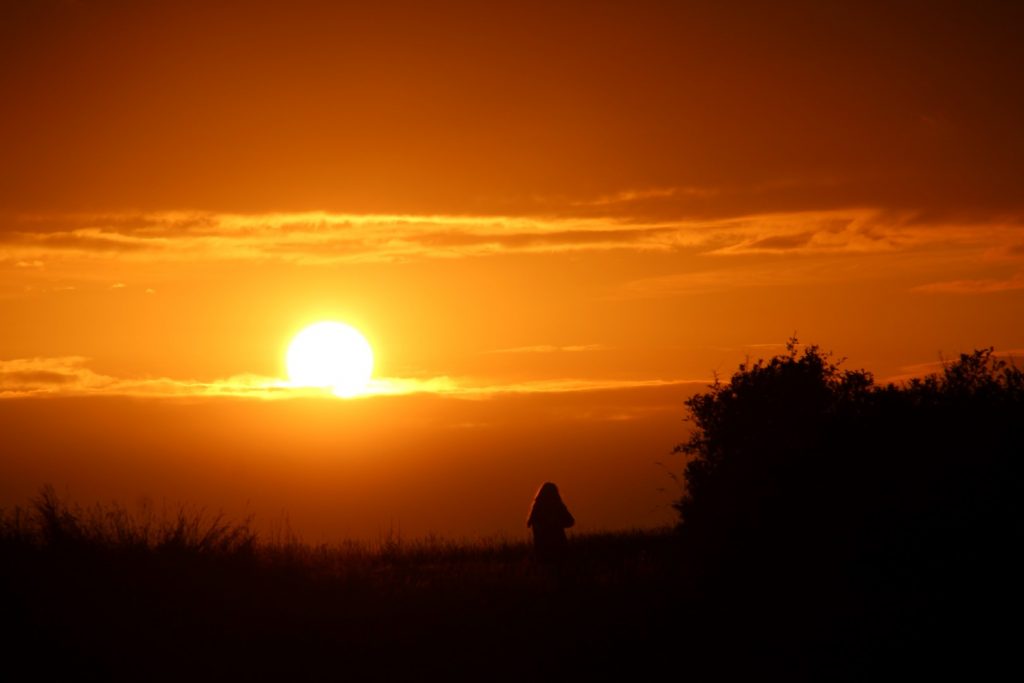


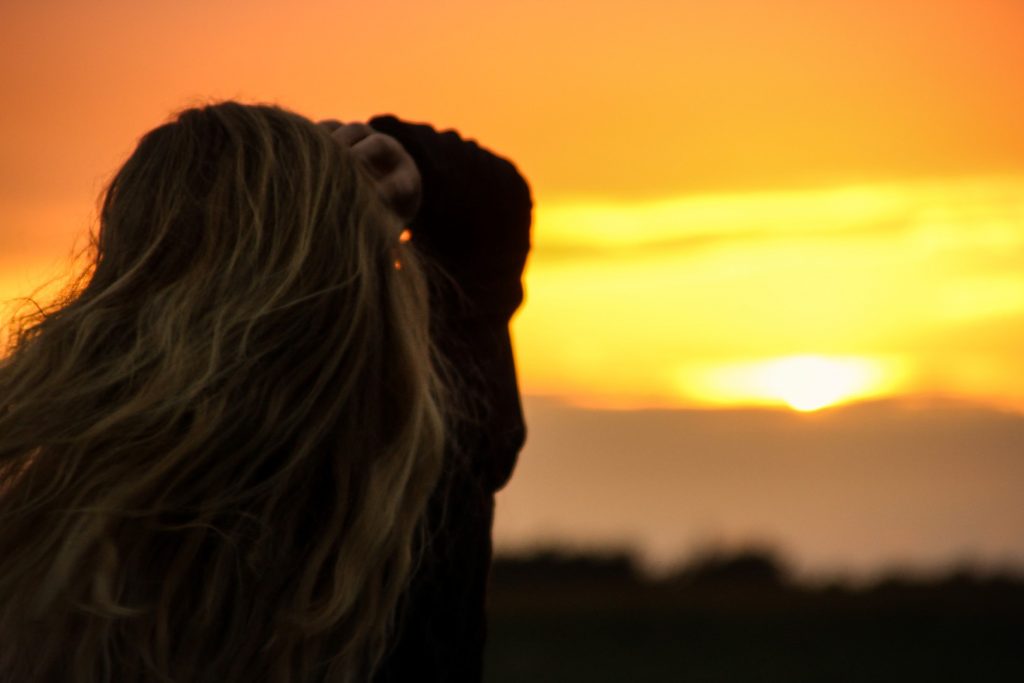
A morning chat by the harbour
The next morning, we woke up to a clear blue sky and temperatures that were a lot higher than we’d anticipated. It was going to be a great day.
We’d arranged to meet up with Jens, the local postman whose wife runs guided tours on the island. We waited by the harbour for Jens to arrive on his yellow moped before seating ourselves on a bench in the sun, ready for an hour of stories and anecdotes from the island.
He told us about the importance of the ferry service, but how the few departures make it impossible to have a 9-5 job on the mainland. But the few departures also has its benefits. Despite having very few children on the island, the school is operational unlike the nearby island of Endelave where the children attend a school on the mainland. Having an operational school is crucial in order for the island to be an attractive place to move to for young families – a group that all the small islands in Denmark want to welcome so the island communities can continue its existence. I’m hoping to see a rise in Tunø’s population in the near future as I don’t want to imagine the day when the community ceases to exist.
Fancy a guided tour with Jens’ wife Hanne? Head over to Tunø Guiden to read more!
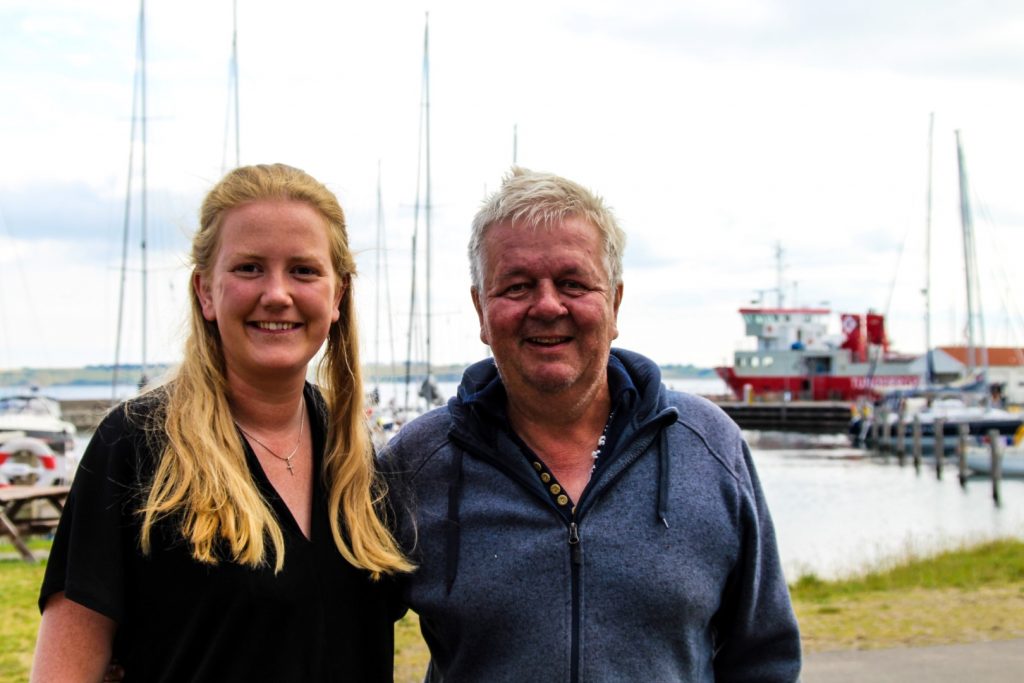
Hiking around Tunø – a 9 km route along the edge of the island
With Jens’ stories and recommendations in mind, we were ready to take on a hike around the entire island, 9 km along the coast and into the center of the island. 9 km doesn’t sound like a lot, and it isn’t, especially since most of the island is flat. In fact, this hike is so easy and well-marked that it’s suitable for small children as well.
And for children, this hike can be made extra fun by a treasure hunt that can result in a medal! To join the hunt, pick up a free copy of the treasure map on the ferry (available in Danish, English and German) and solve the tasks while you make your way around the island. Once you’ve completed all seven tasks, head to the grocery store where you can get the medal as proof of your victory!
BUT don’t fret. The treasure hunt is not just for children – in fact, everyone can join in, so Amanda and I did!
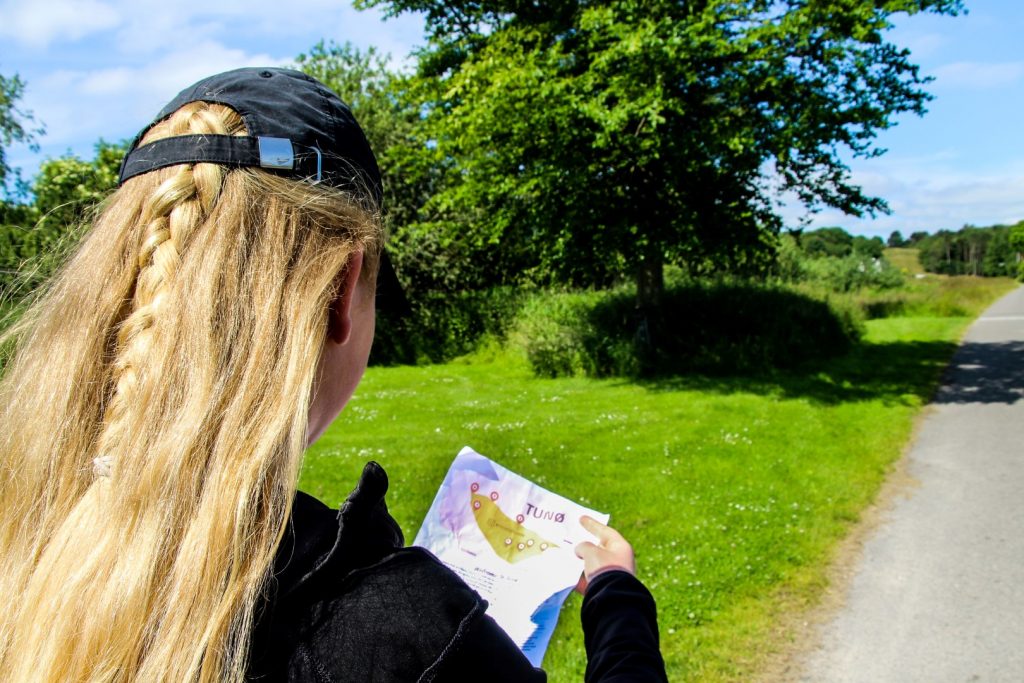
With our treasure map in hand, we walked through the village and into the centre of the island, before making our way to the coast where we started our walk around the entire island while solving the tasks. Our first destination was the bird watching tower on Bjerget (‘the Mountain’), which is the highest point on Tunø at 24 meters above sea level.
It’s well worth walking the few steps up the tower as the view is phenomenal. The panorama isn’t as wide as from the church tower/lighthouse, but it offers a different, more rural view over the bog.
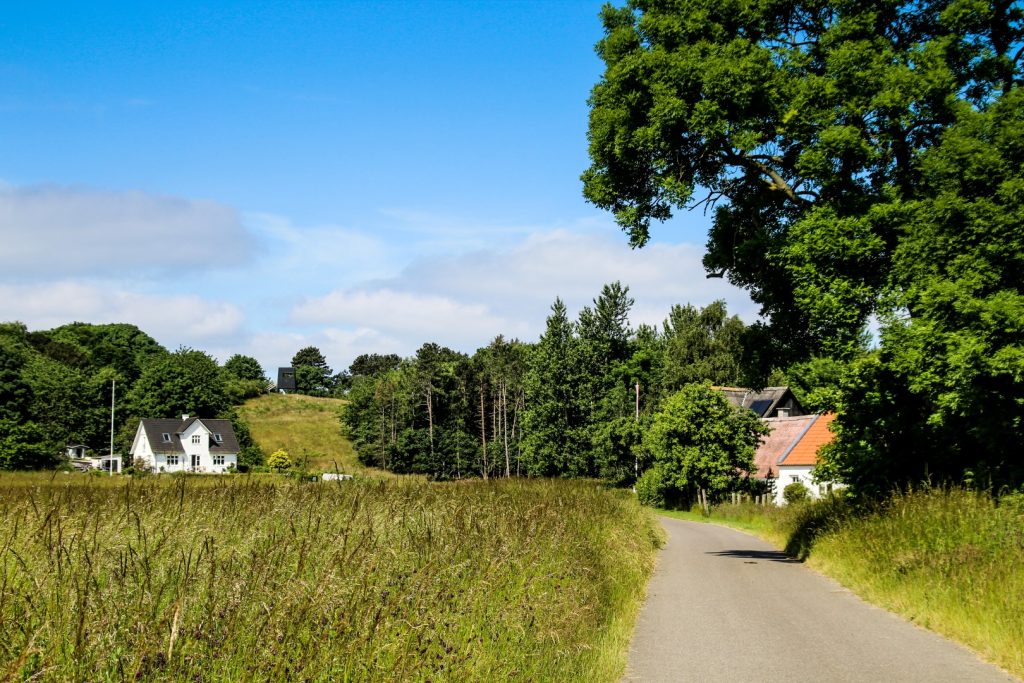

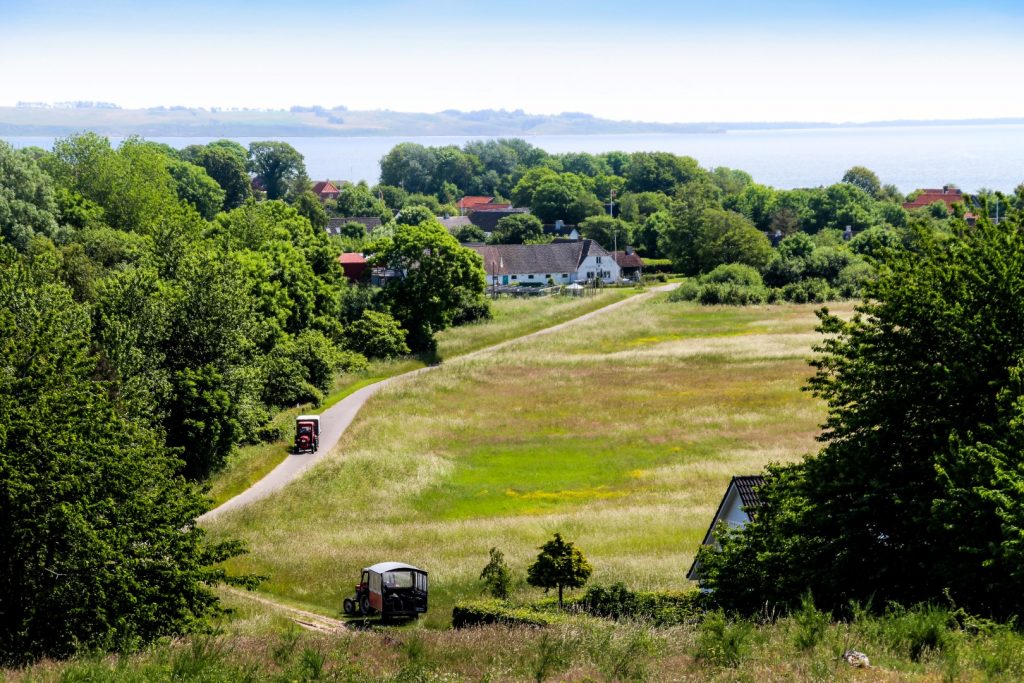
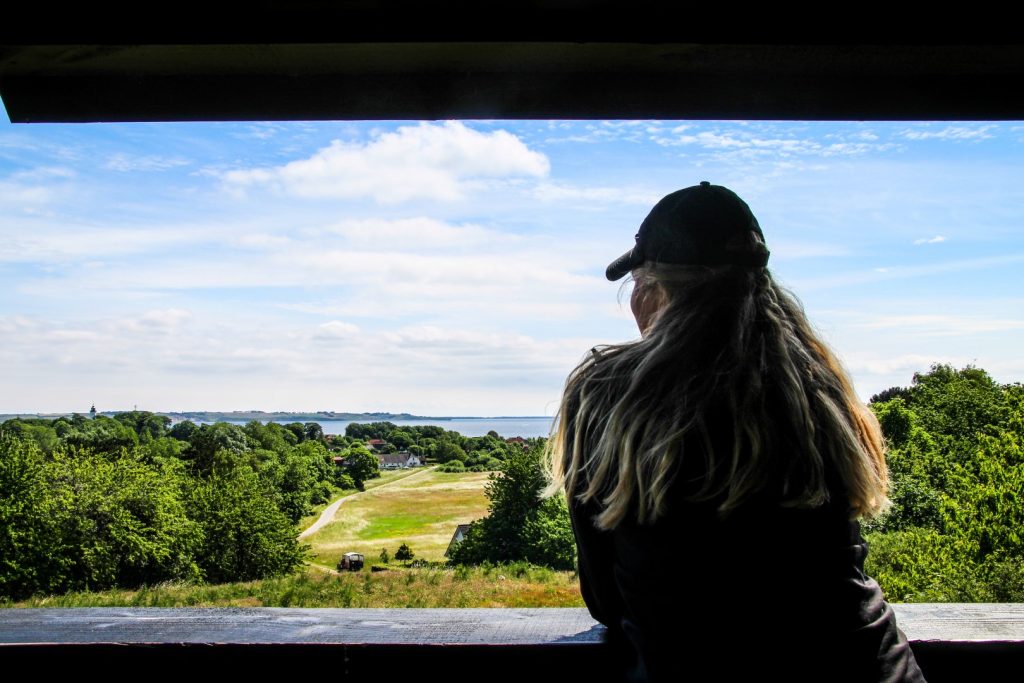
A few meters from the tower, we found a well-trodden path that lead us down to the ocean and onto the red hiking route that follows the coastline.
The nature of Tunø is distinctive, varied and unique, and a walk around the island is the best way to take it all in. We walked along the steep cliffs of Sønderklint which rise up to 23 meters above sea level and stretch around most of the southern and western side of the island. The views from the top of the cliffs were impressive to say the least. We looked back at Hov, my hometown, and soon spotted the ten wind turbines on Tunø Knob that make up the world’s oldest offshore wind farm.
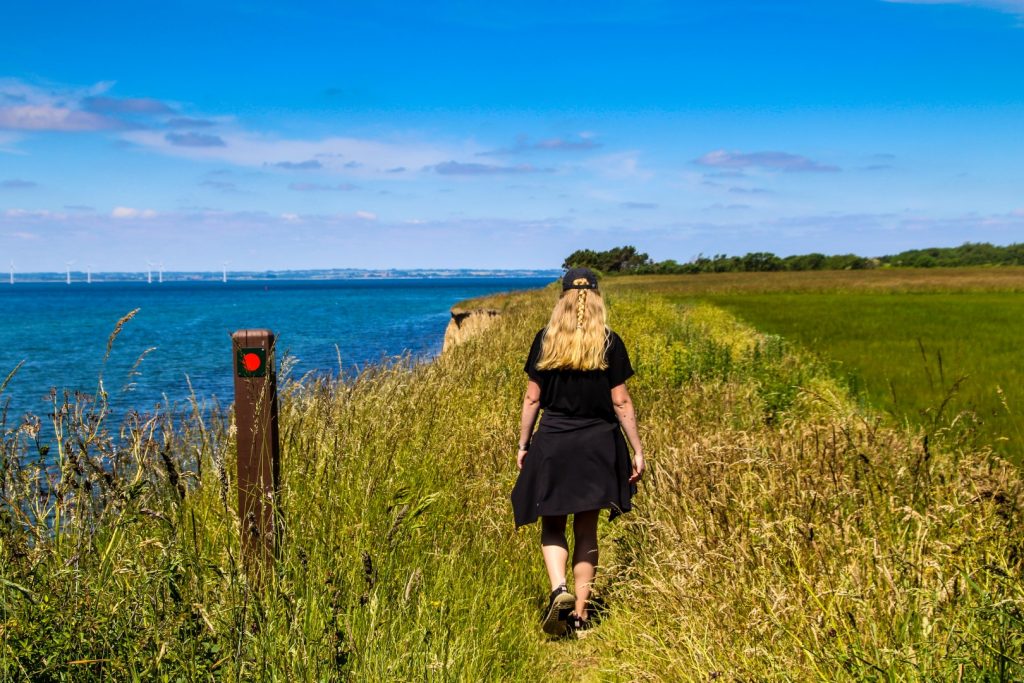
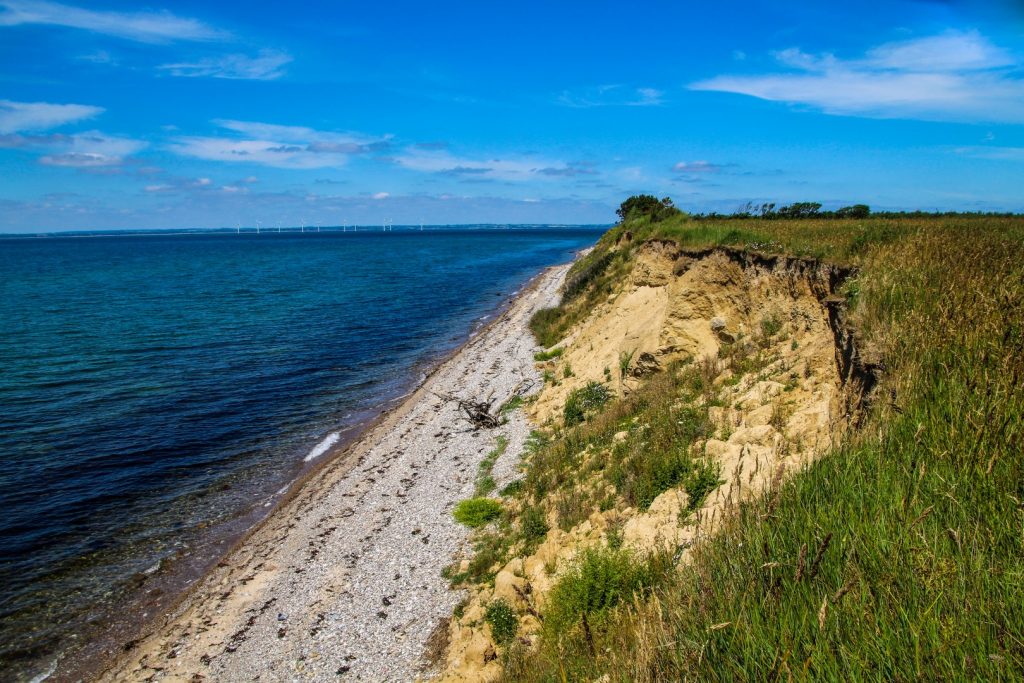
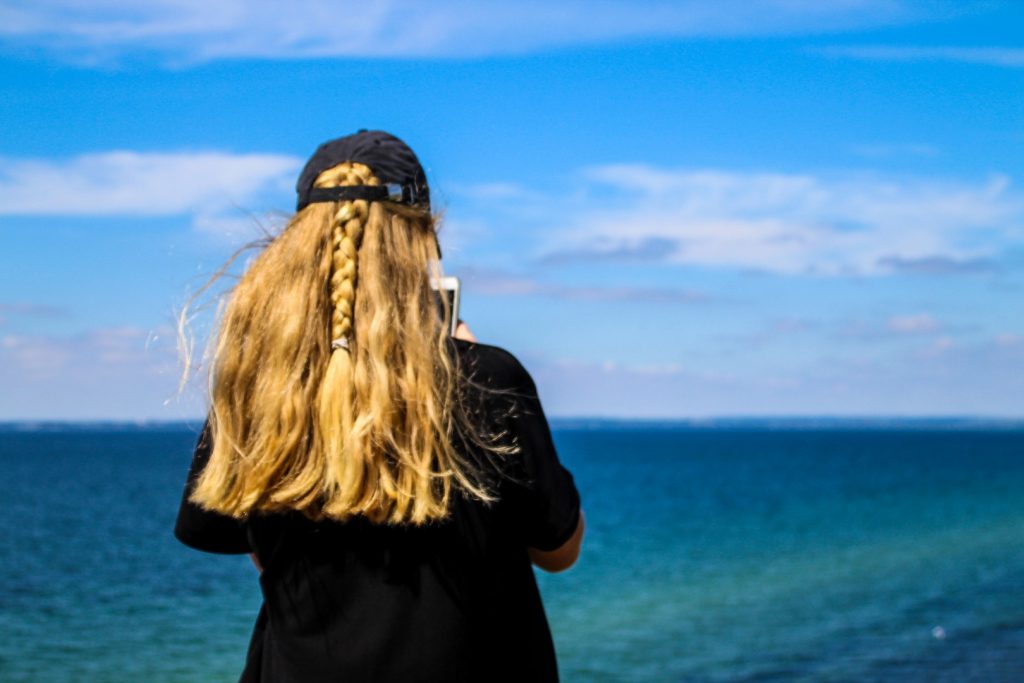


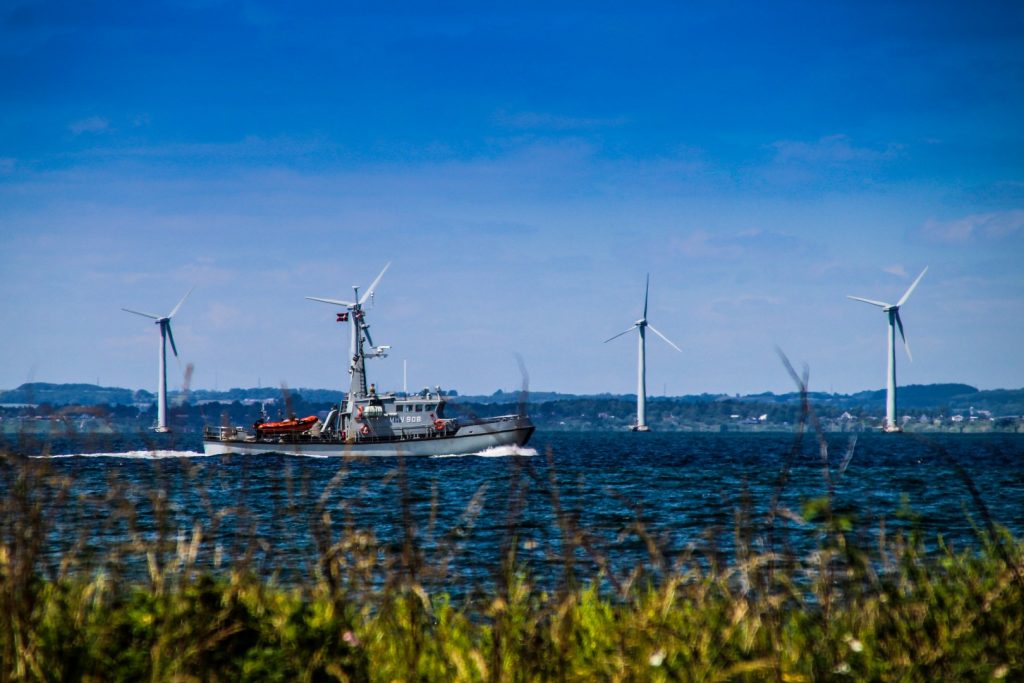
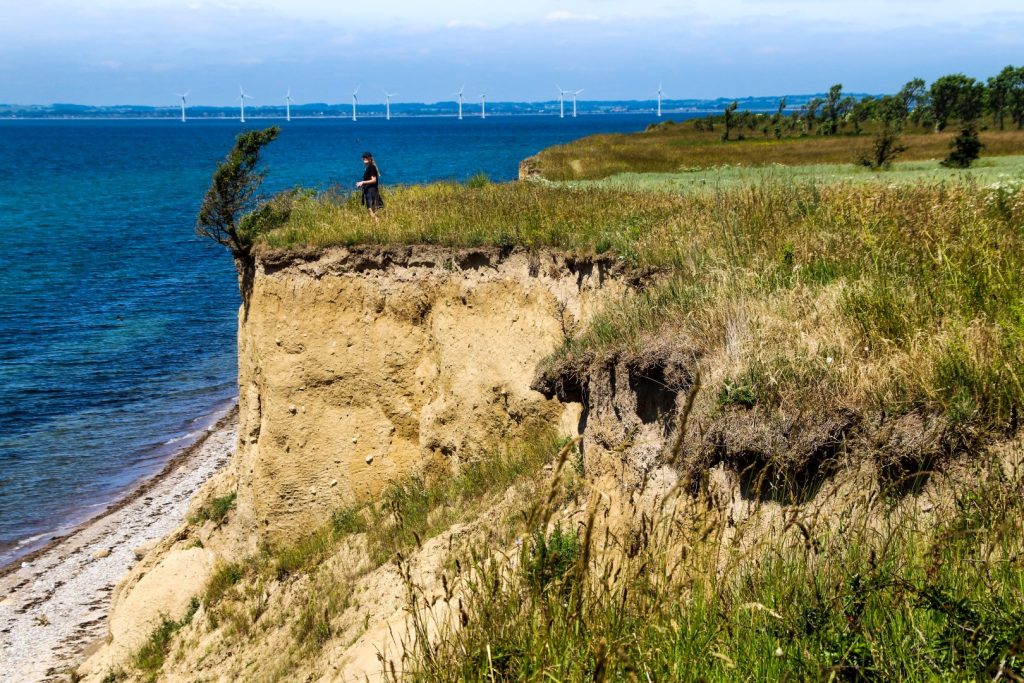
We continued along the west side where the landscape gradually got lower as we approached Stenkalven, the westernmost point of the island.
The area is home to many of the island’s summer houses as well as a small landing strip for private jets. Despite being one of the flattest areas on Tunø, it offers great views of the offshore wind farm as well as the city of Aarhus and Mols Bjerge National Park on the mainland, which we enjoyed while eating our lunch on a wooden bench.
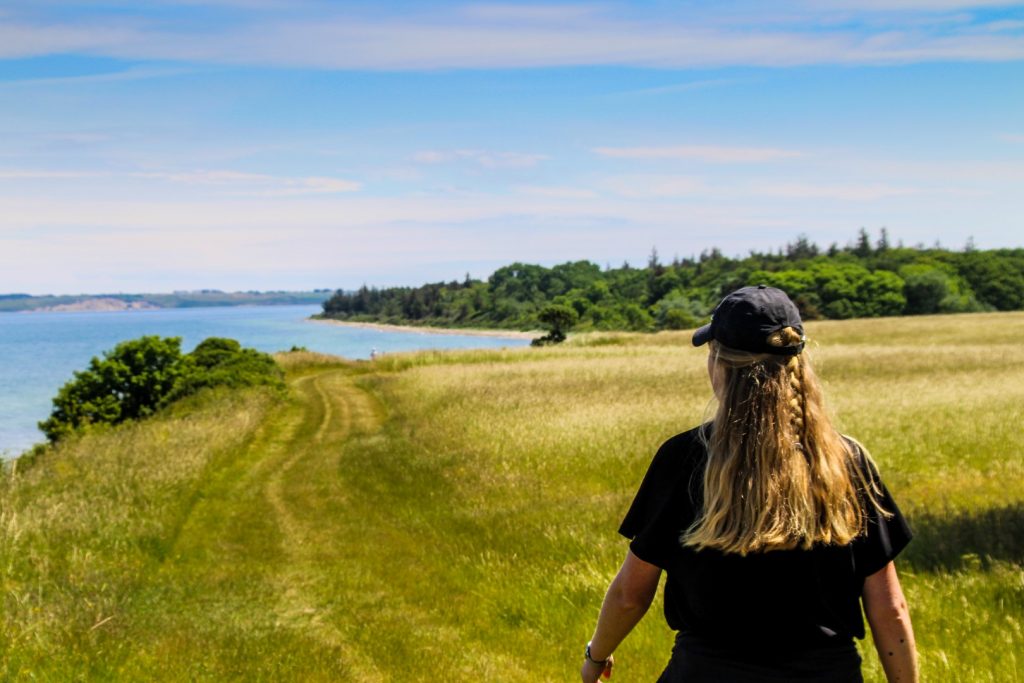
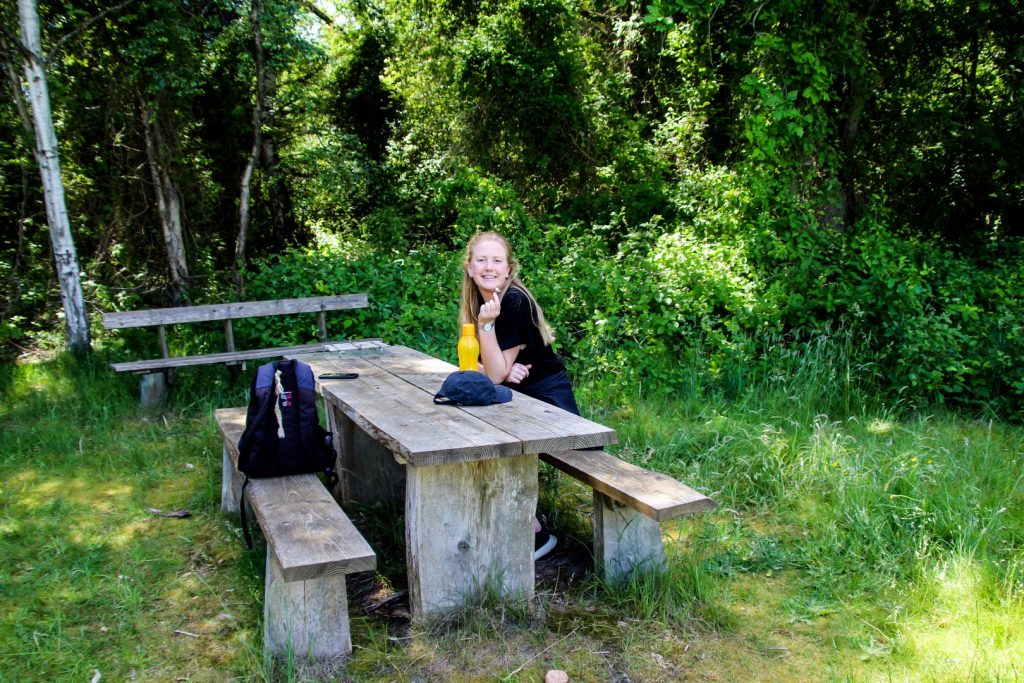
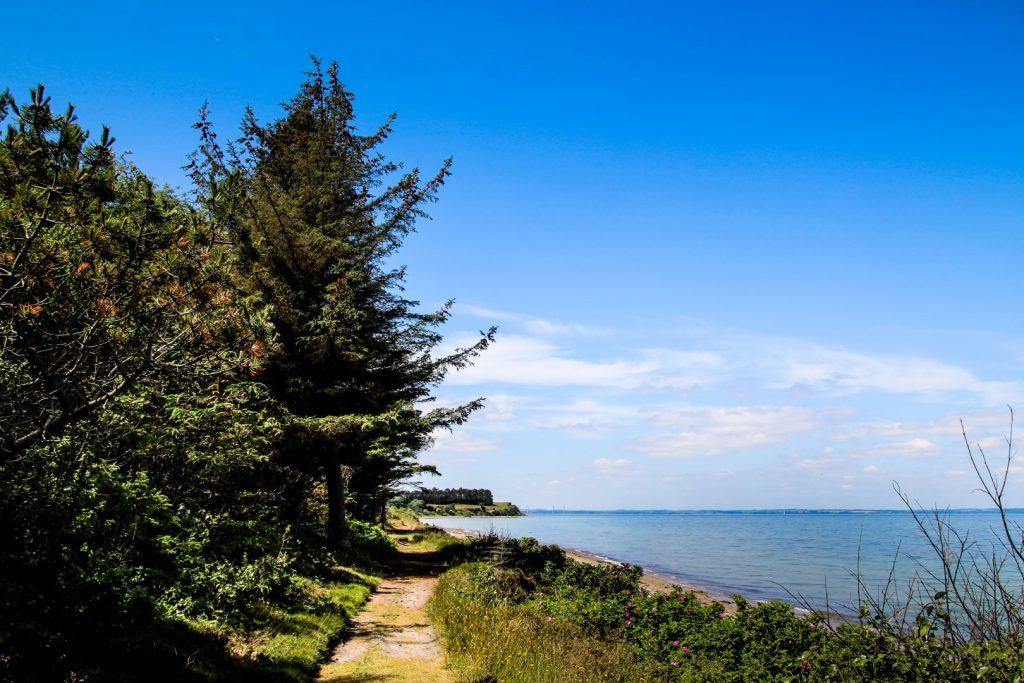
Not long after leaving Stenkalven behind, we started ascending up the cliffs of Nørreklint on the northern side of the island where the northern end of Samsø suddenly came into view. We were also on a lookout for the tiny uninhabited island of Hjelm, which Jens had told us was visible from this area – and sure enough, we could just discern it in the distance.
We were almost at the eastern end of the island when I realized that we’d forgotten to complete the task at Stenkalven! Oh well, it was too late to turn back now – we just had to hope that the grocer would have mercy on us!
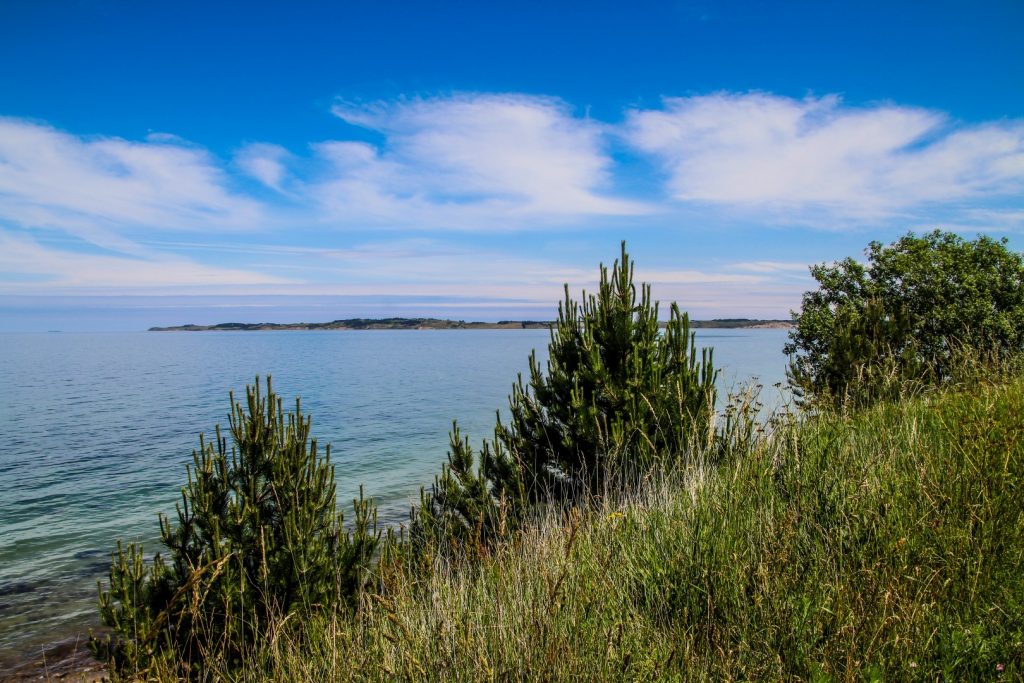
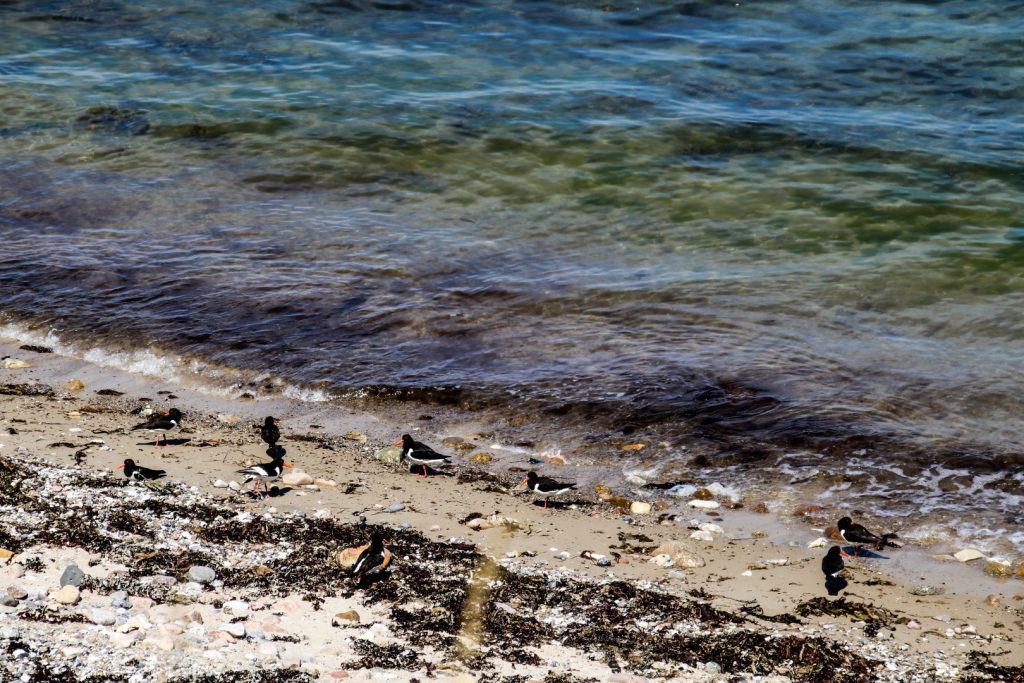
The route took us past a large shelter ground and through a tiny forest to Revet, where we’d gotten our feet wet the day before. We decided to brave it once more – we wanted to see the area in sunny weather!
This time, the seas on both sides of the protrusion were calm so we were able to keep our feet dry while observing the large cormorants and looking back at Tunø from the very edge of Revet.
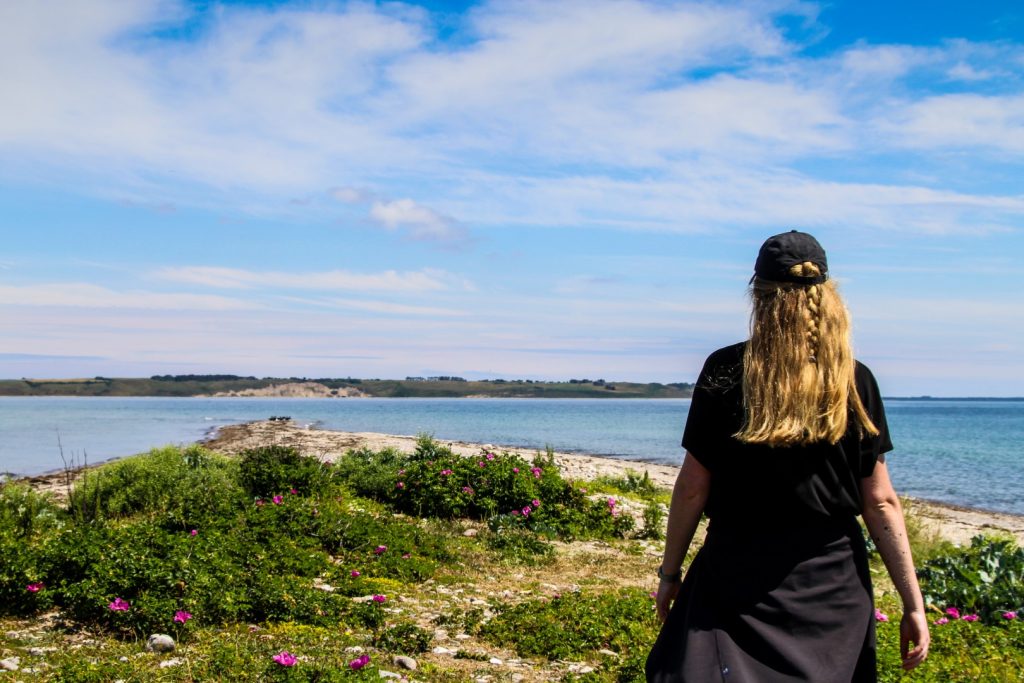
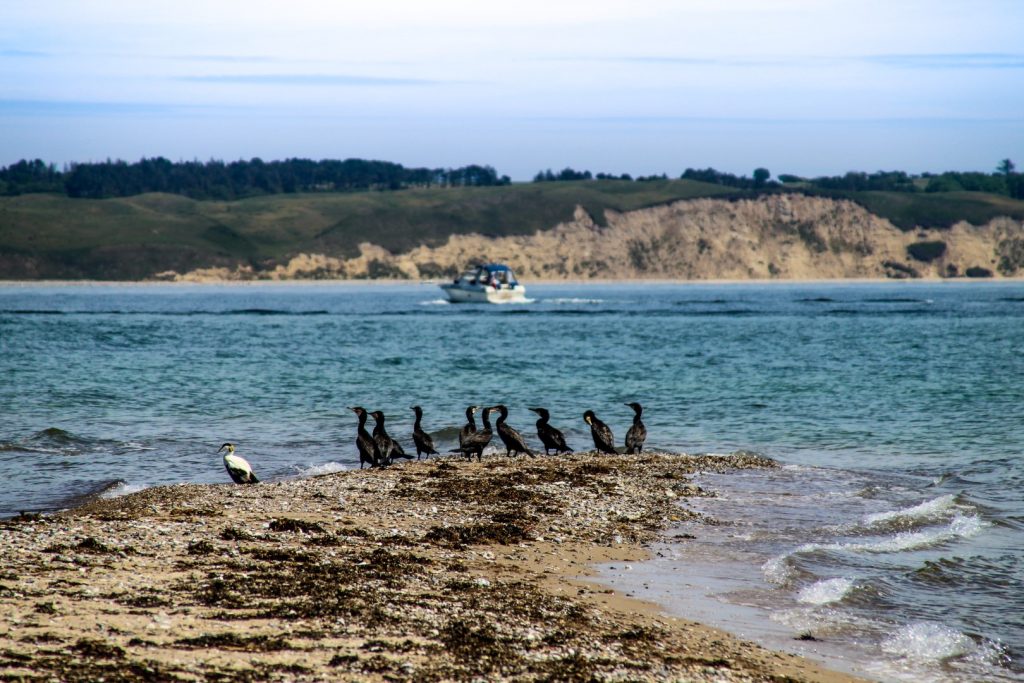
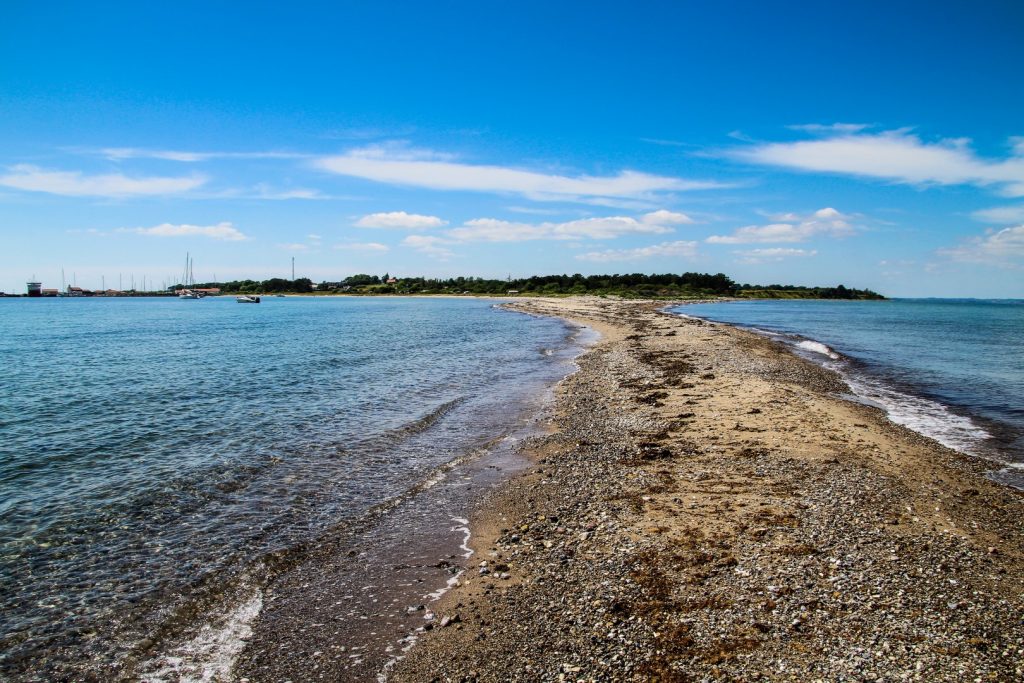
Although we had finished our treasure hunt (with more or less success), we didn’t stop our hike there as we still had to walk around the southeastern coast in order to say that we’d walked around the entire island.
This stretch was particularly beautiful. It followed a section of Sønderklint which gradually got higher as we ascended Højen, a 23 meter high hill that offered a gorgeous view of the village.

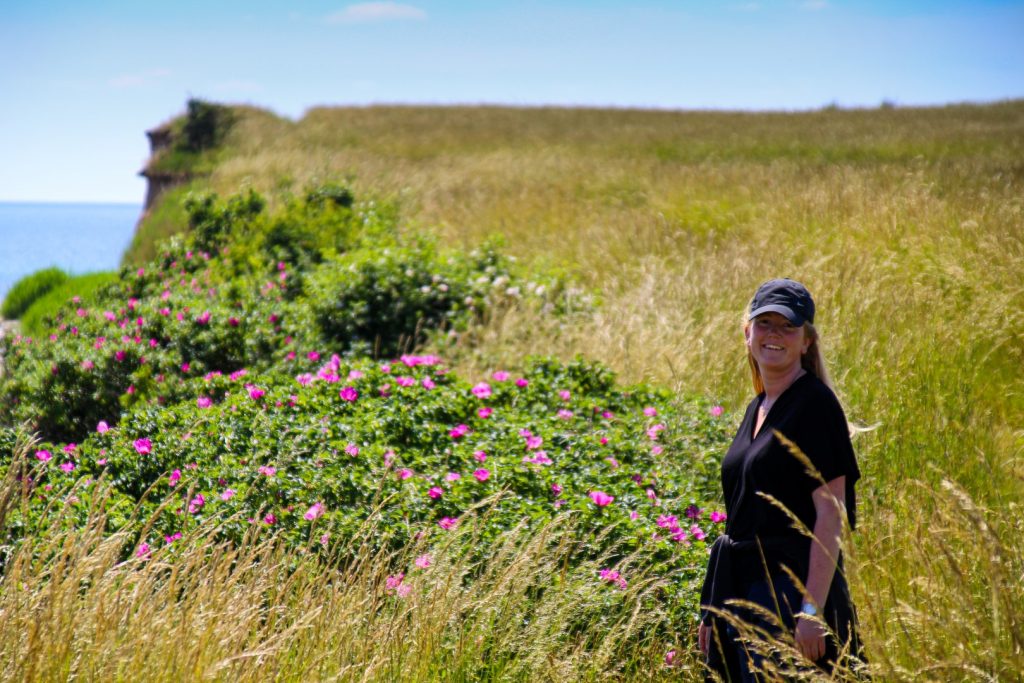
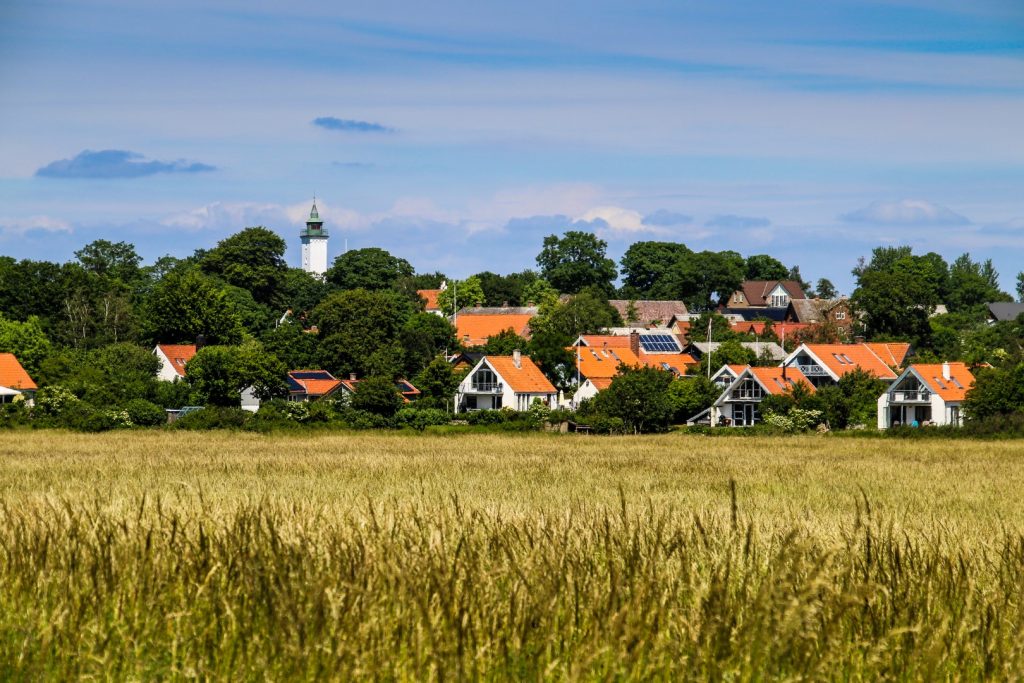
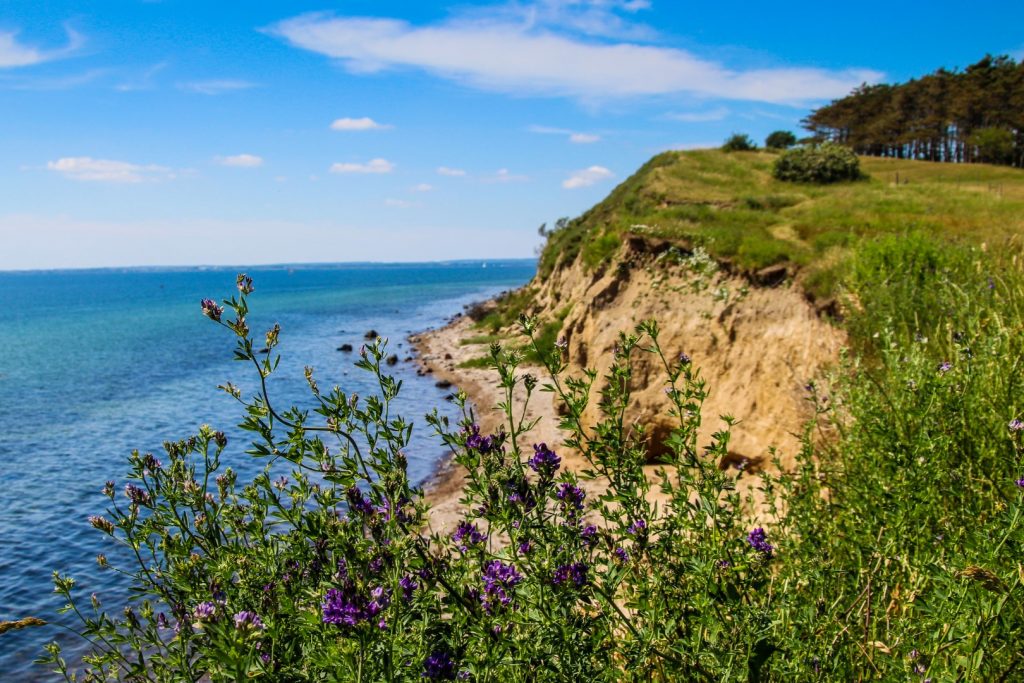
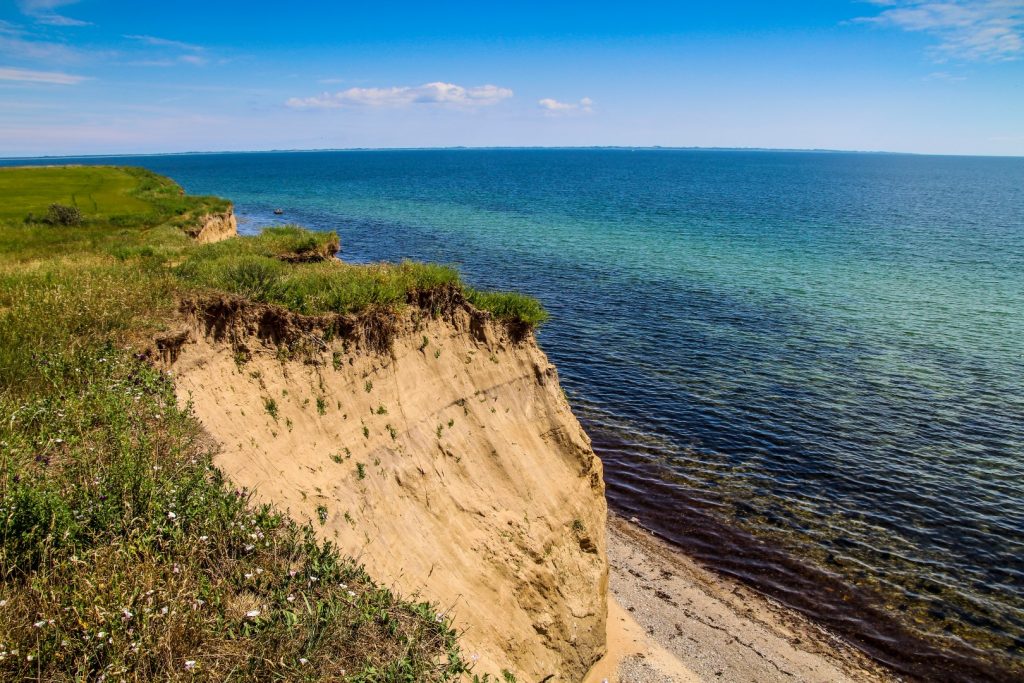
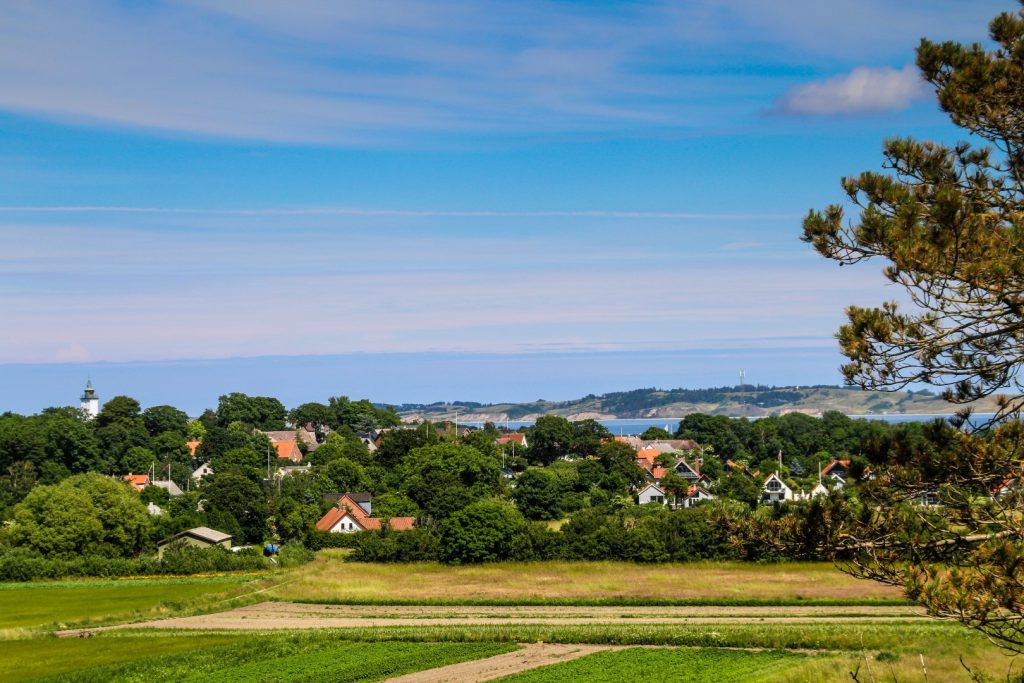
From Højen, we only had a few hundred meters left to complete before finding the footpath that brought us down to the ocean at the beginning of our hike. We followed it back to the bird watching tower and into the village where we headed to the grocery store. Excited and a tad nervous, we walked inside in the hopes of getting our medal even though we hadn’t completed all tasks. The kind grocer had mercy on us and gave us both our (maybe slightly undeserved) medals. We’d done it! Sort of… I’m sure any child could do better than us!
We arrived back at our cabin four hours after we’d set off on our hike. The route usually takes just 2-3 hours to complete, but everything takes much longer for two shutterbugs!
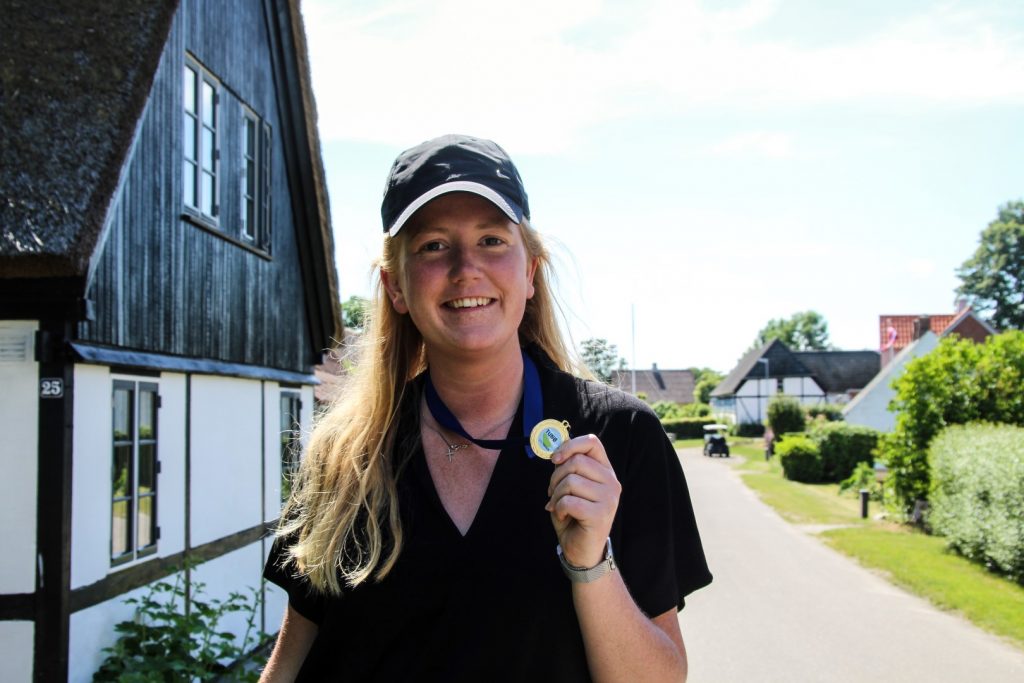
A dip in the ocean at Nordstrand
It was nearing the end of our time on Tunø, but there was one thing I had to do before leaving. I HAD to test out the ocean; my overheated body needed it!
So I put on my swimsuit for the first time in 2020 and headed to the beautiful beach Nordstrand, where I took a refreshing dip in the clean ocean. It felt amazing. If only we could’ve stayed there for longer!
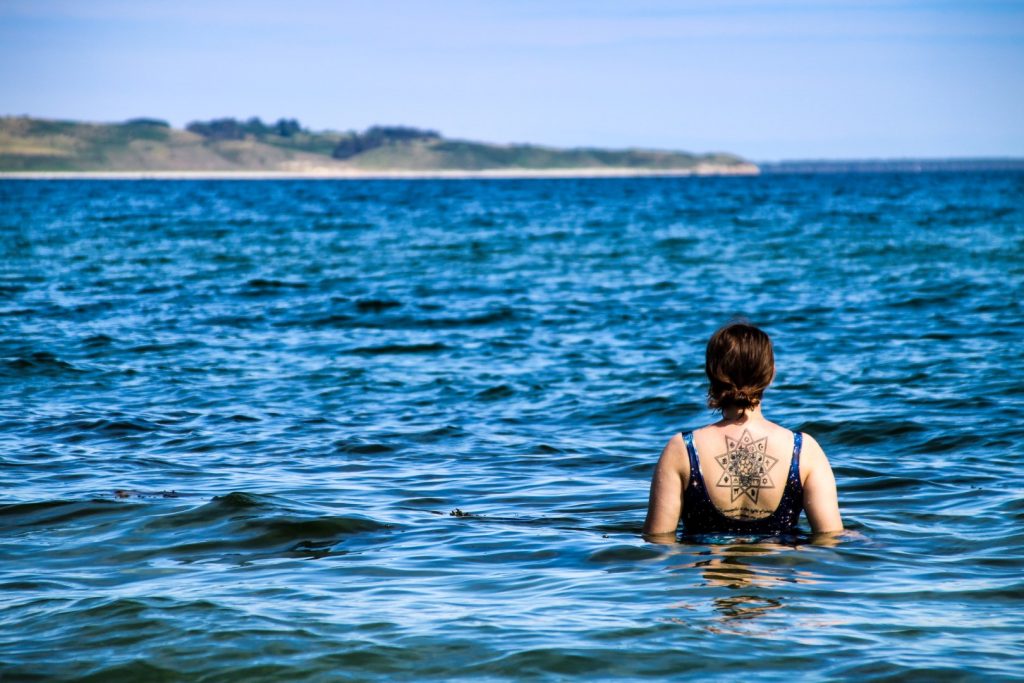
With fresh vegetables in hand, we said goodbye to Tunø
The time had come for us to head to the harbour so we could catch the ferry back to the mainland, but we had one more thing we wanted to do while on Tunø; to buy some of the delicious local seasonal vegetables from one of the roadside stalls! I bought yellow onion, red onion, spring onion, carrots, fennel and peas and Amanda settled for a bag of potatos. Now we were all set and ready to go home (to cook some beautiful veggie dishes!).
We sat outside on the deck for most of the trip as the weather was still gorgeous. It was wonderful to look back at the island as we sailed away from it. I don’t know why, but I always miss Tunø immediately whenever I leave the place. There’s something truly special about the island, something that’s impossible to describe. It has to be experienced.
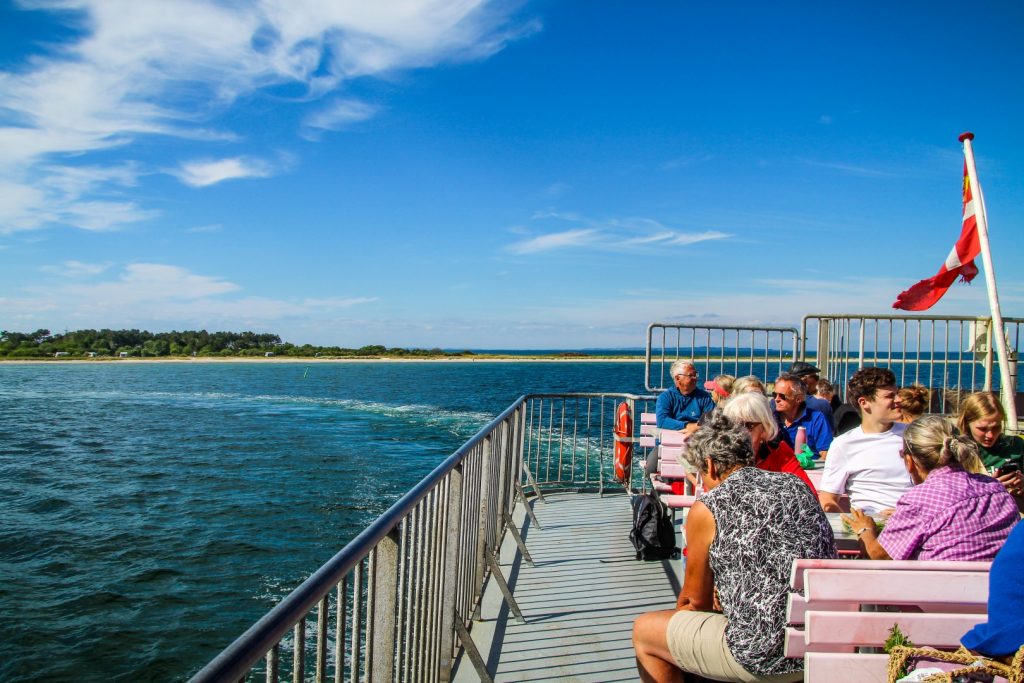
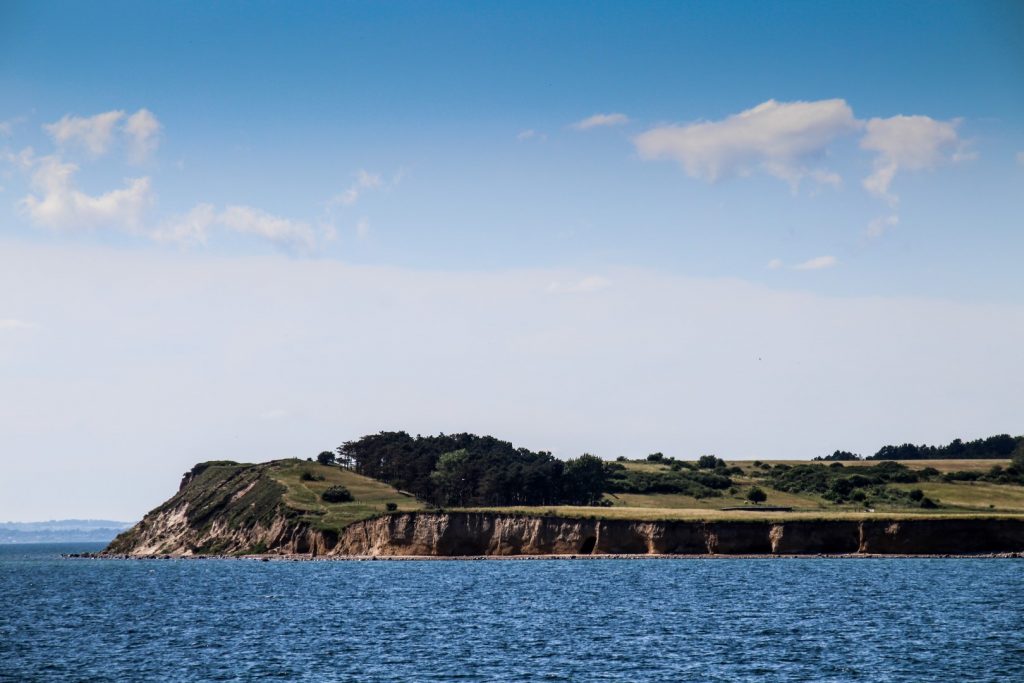
Back in Hov – time for ice cream!
An hour later, we arrived back in Hov, but our weekend of fun didn’t end there. We finished off with an ice cream at the newly opened Mosters Ishus, a cozy little place that I’ve already visited many times this summer.
I got a delicious vegan ice cream and Amanda enjoyed an old-fashioned ice cream waffle cone. We sat on a bench outside in the sunshine to eat our ice creams while chatting about the wonderful weekend that had just passed.
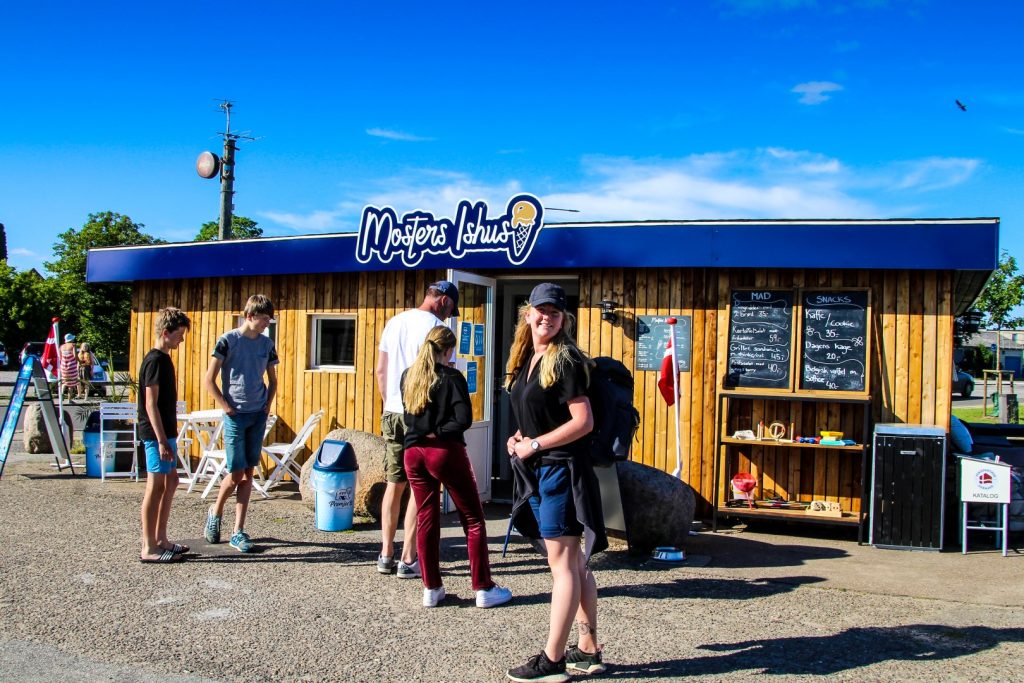
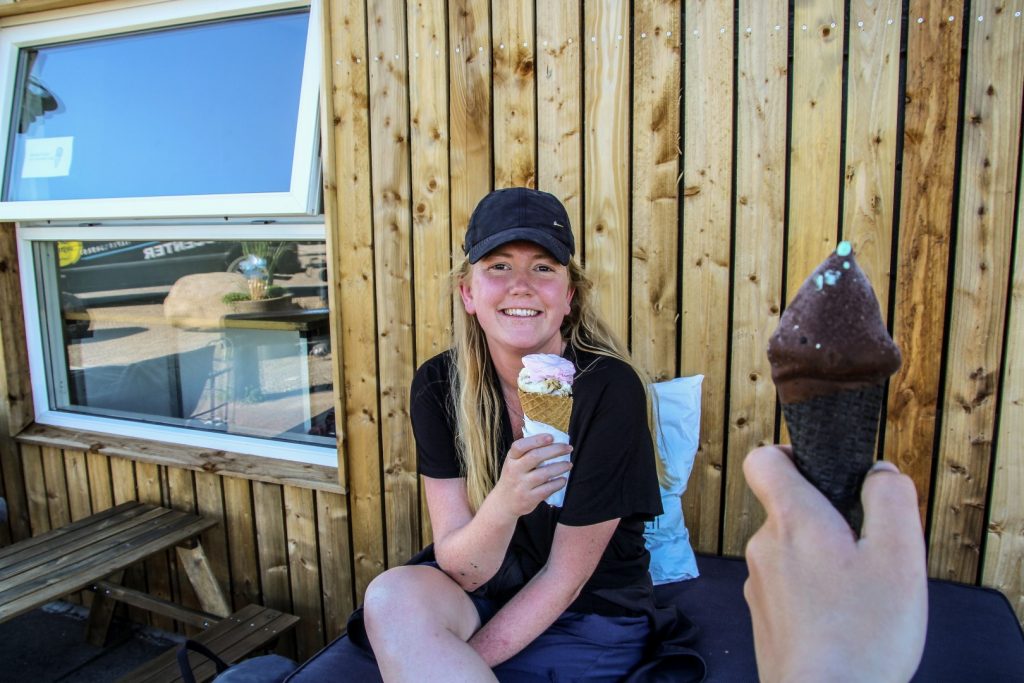
Travel info on Tunø
WHEN TO GO: Tunø is accessible year-round, although it’s a much more popular destination in the summer. I’m sure that winter on the island is amazing (especially when it snows), but do realize that most cafés, restaurants, accommodation options and activities will be closed in the winter season.
HOW TO GET THERE: The ferry to Tunø departs from Hov, a small harbour town near Odder on Jutland’s East coast. To get to Hov, you can catch bus 103 from Odder (see the timetables here). You don’t need to book a spot on the bus in advance, but know that you cannot pay with credit card on the bus. The ferry to Tunø departs daily and takes about 60 minutes (see the timetable and book your ticket here).
GETTING AROUND: As the island is car-free, you only have three options for getting around on the island. You can walk, bring or rent a bike or take the local taxi, which is a tractor (the locals call it a traxa!). Find more info on the traxa here and more info on bike rental here.
ACCOMMODATION: There are plenty of options for accommodation on the island (see here). For budget friendly options, you can sleep for free in one of the island’s shelters or book a spot for your tent at Tunø Teltplads for 62 DKK per night. For a more comfortable night, I recommend renting a cabin at the campsite from 350 DKK per night (sleeps four people).
EATING AND DRINKING: There are many places to eat and drink on the island. There’s a small supermarket with an adjacent café which is open daily. During the summer, you can choose between Mejeriet Tunø, Tunø Røgeri and Thunø Kro, the café at the supermarket, the café at Galleri Eggertart and the café at the minigolf course. Mejeriet Tunø will serve vegan food if you order a day in advance – otherwise their fries are delicious!
ACTIVITIES: There is a lot to see and do on Tunø! I recommend hiking around the island (and if you’re bringing children or just enjoy a bit of fun yourself, don’t forget to get a treasure map on the ferry!), visiting the church tower/lighthouse, playing minigolf and visiting the museum and the old smithy. And don’t forget to swing by one of the vegetables stalls before you leave the island – you won’t find better or cheaper vegetables anywhere else in Denmark!
↠ This trip was made in collaboration with Visit Odder, but all opinions expressed are solely my own ↞
Leave a Comment
Pingback: Cloudy day on Samsø: A family outing to the island across the sound – Northtrotter on 03/07/2020
Pingback: Venture beyond Copenhagen: 20 beautiful places to explore in rural Denmark – Northtrotter on 03/07/2020
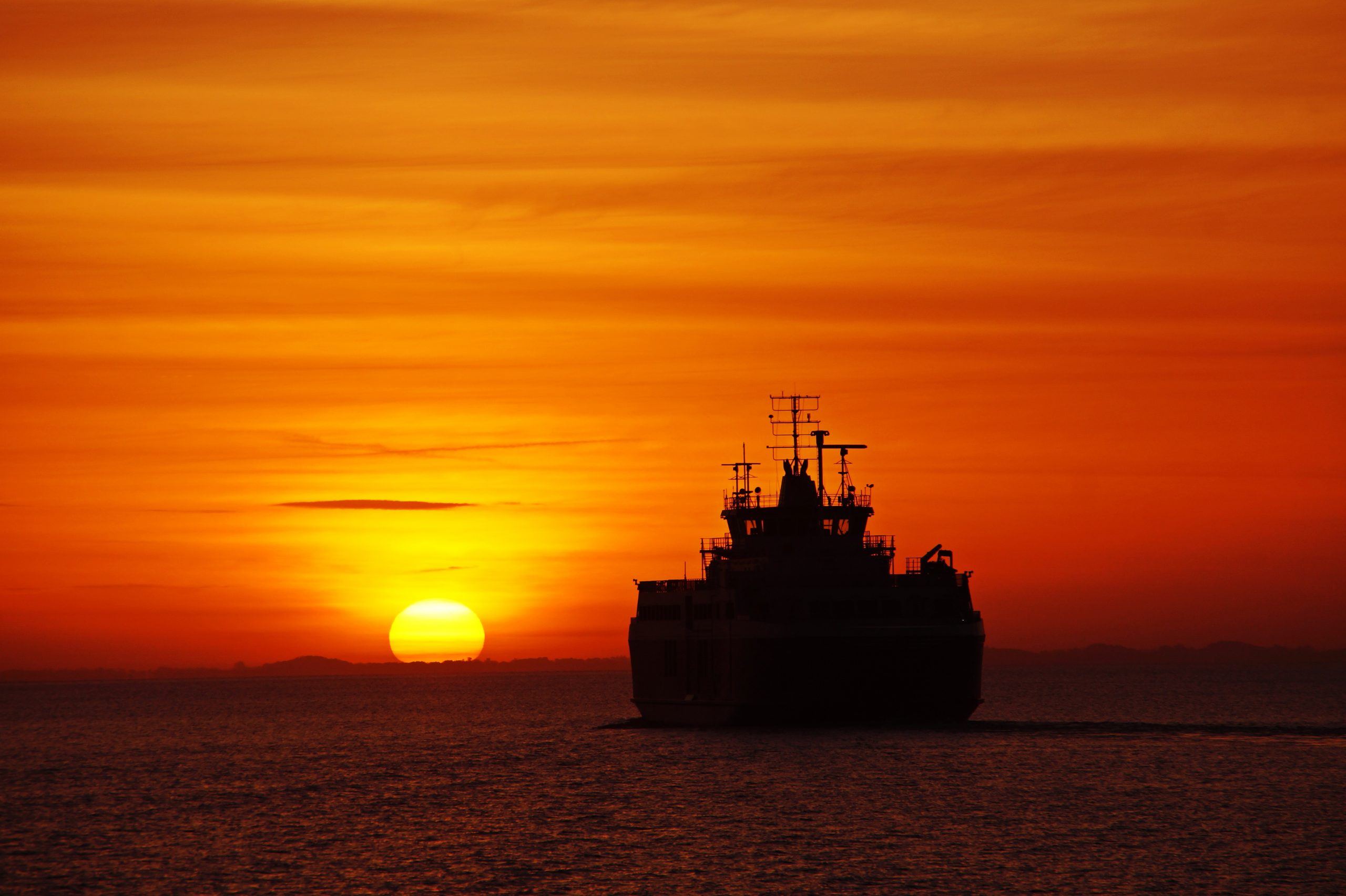

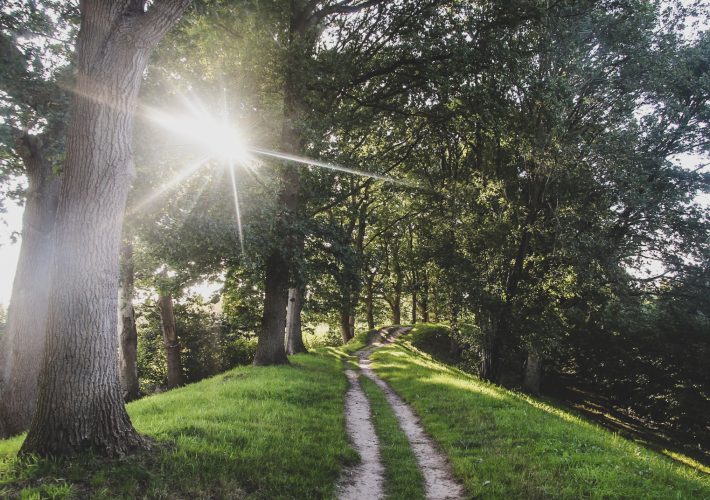
2 COMMENTS